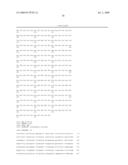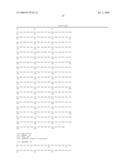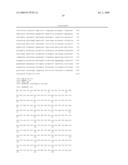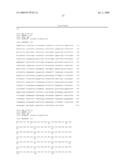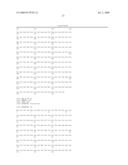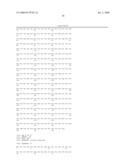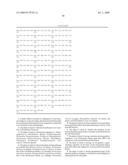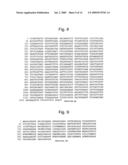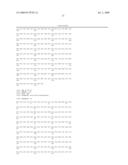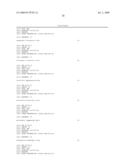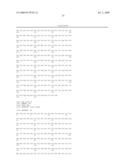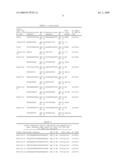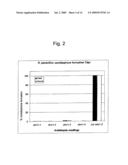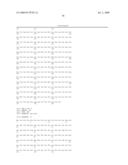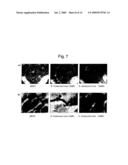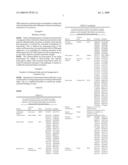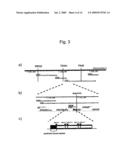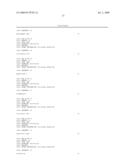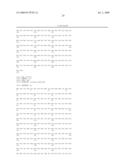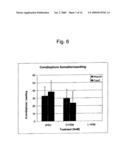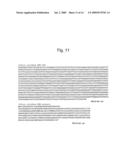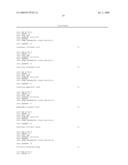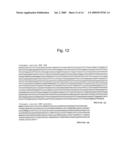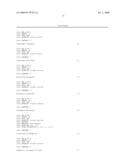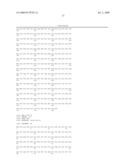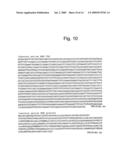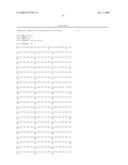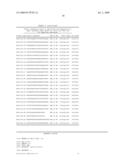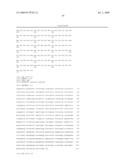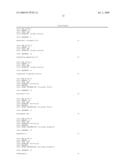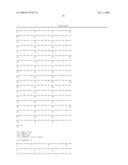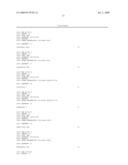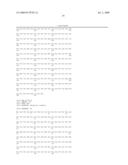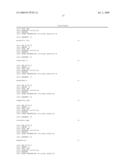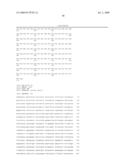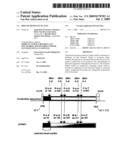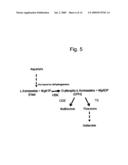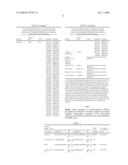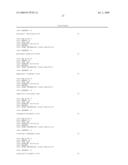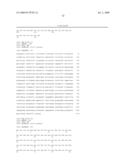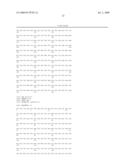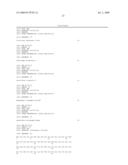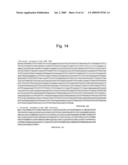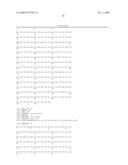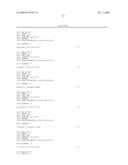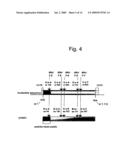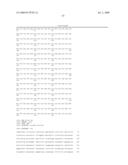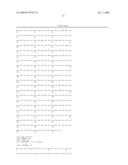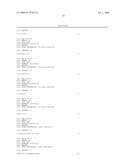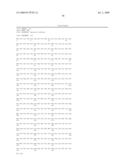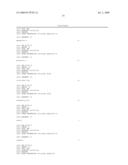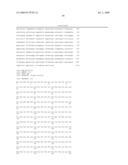Patent application title: Disease Resistant Plants
Inventors:
Augustinus Franciscus Johannes Maria Van Den Ackerveken (Houten, NL)
Augustinus Franciscus Johannes Maria Van Den Ackerveken (Houten, NL)
Mireille Maria Augusta Van Damme (Amsterdam, NL)
Assignees:
Universiteit Utrecht Holding B.V.
IPC8 Class: AA01N3702FI
USPC Class:
504307
Class name: Plant growth regulating compositions (e.g., herbicides, etc.) organic active compound containing containing -c(=x)x-, wherein the x`s are the same or diverse chalcogens, and at least one x is other than oxygen (e.g., thiocarboxylates, etc.)
Publication date: 2009-07-02
Patent application number: 20090170703
Inventors list |
Agents list |
Assignees list |
List by place |
Classification tree browser |
Top 100 Inventors |
Top 100 Agents |
Top 100 Assignees |
Usenet FAQ Index |
Documents |
Other FAQs |
Patent application title: Disease Resistant Plants
Inventors:
Augustinus Franciscus Johannes Maria Van Den Ackerveken
Mireille Maria Augusta Van Damme
Agents:
MORGAN, LEWIS & BOCKIUS, LLP
Assignees:
Universiteit Utrecht Holding B.V.
Origin: SAN FRANCISCO, CA US
IPC8 Class: AA01N3702FI
USPC Class:
504307
Abstract:
The present invention relates to a plant, which is resistant to a pathogen
of viral, bacterial, fungal or oomycete origin, wherein the plant has an
increased homoserine level as compared to a plant that is not resistant
to the said pathogen, in particular organisms of the phylum Oomycota. The
invention further relates to a method for obtaining a plant, which is
resistant to a pathogen of viral, bacterial, fungal or oomycete origin,
comprising increasing the endogenous homoserine level in the plant.Claims:
1. A plant, which is resistant to a pathogen of viral, bacterial, fungal
or oomycete origin, characterized in that the plant has an increased
homoserine level as compared to a plant that is not resistant to the said
pathogen.
2. The plant of claim 1, wherein the pathogen is an organism of the phylum Oomycota.
3. The plant of claim 2, wherein the pathogen is a Albugo, Aphanomyces, Basidiophora, Bremia, Hyaloperonospora, Pachymetra, Paraperonospora, Perofascia, Peronophythora, Peronospora, Peronosclerospora, Phytium, Phytophthora, Plasmopara, Protobremia, Pseudoperonospora, Sclerospora, Viennotia species.
4. The plant of claim 2, wherein the plant and the pathogen are selected from Bremia lactucae on lettuce, Peronospora farinosa on spinach, Pseudoperonospora cubensis on members of the Cucurbitaceae family, e.g. cucumber, Peronospora destructor on onion, Hyaloperonospora parasitica on members of the Brasicaceae family, e.g. cabbage, Plasmopara viticola on grape, Phytophthora infestans on tomato and potato, and Phytophthora sojae on soybean.
5. The plant of claim 1, having a mutation in its homoserine kinase gene that affects the homoserine kinase activity of the encoded enzyme.
6. The plant of claim 5, wherein the mutation in the homoserine kinase gene leads to an amino acid substitution in the encoded protein.
7. The plant of claim 1, having a mutation in the regulatory sequences of its homoserine kinase gene that affects the expression of the encoded homoserine kinase.
8. The plant of claim 1, having a in its genome a gene-silencing construct on the basis of the homoserine kinase gene that affects the expression of the encoded homoserine kinase.
9. The plant of claim 1, having upregulated genes in the aspartate pathway leading to an increase in the endogenous homoserine level in the plant.
10. The plant of claim 5, wherein the gene is an orthologous gene of the Arabidopsis gene having a nucleotide sequence according to SEQ ID NO: 99 or an amino acid sequence according to SEQ ID NO: 100.
11. The plant of claim 5, wherein the gene is a homoserine kinase gene.
12. The plant of claim 5, wherein the gene is the homoserine kinase gene of Lactuca sativa having a nucleotide sequence according to SEQ ID NO: 101 or an amino acid sequence according to SEQ ID NO: 102.
13. The plant of claim 5, wherein the gene is the homoserine kinase gene of Vitis vinifera having a nucleotide sequence according to SEQ ID NO: 103 or an amino acid sequence according to SEQ ID NO: 104.
14. The plant of claim 5, wherein the gene is the homoserine kinase gene of Cucumis sativus having a nucleotide sequence according to SEQ ID NO: 105 or an amino acid sequence according to SEQ ID NO: 106.
15. The plant of claim 5, wherein the gene is the homoserine kinase gene of Spinacia oleracea having a nucleotide sequence according to SEQ ID NO: 107 or an amino acid sequence according to SEQ ID NO: 108.
16. The plant of claim 5, wherein the gene is the homoserine kinase gene of Solanum lycopersicum having a nucleotide sequence according to SEQ ID NO: 109 or an amino acid sequence according to SEQ ID NO: 110.
17. A method for obtaining a plant, which is resistant to a pathogen of viral, bacterial, fungal or oomycete origin, the method comprising increasing the endogenous homoserine level in the plant.
18. The method as claimed in of claim 17, wherein increasing the endogenous homoserine level in the plant is achieved by external administration of homoserine to the plant.
19. The method of claim 18, wherein homoserine is administered to the plant by treatment of seedlings by spraying or infiltration with homoserine.
20. The method of claim 17, wherein increasing the endogenous homoserine level in the plant is achieved by mutation of the homoserine kinas gene of the plant.
21. The method of claim 20, wherein the mutation results in one or more amino acid changes that lead to a lower homoserine kinase activity.
22. The method of claim 20, wherein the mutation is effected by mutagenic treatment of the plant, wherein the mutagenic treatment comprises applying a mutagen or radiation.
23. The method of claim 17, wherein increasing the endogenous homoserine level in the plant is achieved by reducing the expression of the homoserine kinase gene of the plant.
24. The method of claim 23, wherein reducing the expression of the homoserine kinase gene of the plant is achieved by gene silencing or RNAi.
25. The method of claim 23, wherein reducing the expression of the homoserine kinas gene of the plant is achieved by mutagenesis of regulatory elements in the promoter region, terminator region or an intron.
26. The method of claim 23, wherein reducing the expression of the homoserine kinase gene of the plant is achieved by overexpressing repressor proteins of the homoserine kinase gene.
27. The method of claim 26, wherein the homoserine kinase gene is expressed from the 35S promoter.
28. The method of claim 23, wherein reducing the expression of the homoserine kinase gene of the plant is achieved by silencing or mutation of plant genes encoding homoserine kinase activating or regulatory proteins.
29. The method of claim 17, wherein increasing the endogenous homoserine level in the plant is achieved by inducing alterations in the aspartate pathway.
30. The method of claim 21, wherein the homoserine kinase gene to be mutated is an orthologous gene of the Arabidopsis gene having a nucleotide sequence according to SEQ ID NO: 99.
31. The method of claim 30, wherein the orthologous gene is the homoserine kinase gene of Lactuca sativa having a nucleotide sequence according to SEQ ID NO: 101 or an amino acid sequence according to SEQ ID NO: 102.
32. The method of claim 30, wherein the orthologous gene is the homoserine kinase gene of Vitis vinifera having a nucleotide sequence according to SEQ ID NO: 103 or an amino acid sequence according to SEQ ID NO: 104.
33. The method of claim 30, wherein the orthologous gene is the homoserine kinase gene of Cucumis sativus having a nucleotide sequence according to SEQ ID NO: 105 or an amino acid sequence according to SEQ ID NO: 106.
34. The method of claim 30, wherein the orthologous gene is the homoserine kinase gene of Spinacia oleracea having a nucleotide sequence according to SEQ ID NO: 107 or an amino acid sequence according to SEQ ID NO: 108.
35. The method of claim 30, wherein the orthologous gene is the homoserine kinase gene of Solanum lycopersicum having a nucleotide sequence according to SEQ ID NO: 109 or an amino acid sequence according to SEQ ID NO: 110.
36. Mutated plant HSK gene encoding a homoserine kinase having a reduced enzymatic activity.
37. Mutated plant HSK gene as claimed in claim 36, selected from the group consisting of the dmr1 alleles dmr1-1, dmr1-2, dmr1-3, dmr1-4 and dmr1-5.
Description:
[0001]The present invention relates to disease resistant plants, in
particular plants resistant to organisms of the phylum Oomycota, the
oomycetes. The invention further relates to plant genes conferring
disease resistance and methods of obtaining such disease resistant plants
for providing protection to Oomycota pathogens.
[0002]Resistance of plants to pathogens has been extensively studied, for both pathogen specific and broad resistance. In many cases resistance is specified by dominant genes for resistance. Many of these race-specific or gene-for-gene resistance genes have been identified that mediate pathogen recognition by directly or indirectly interacting with avirulence gene products or other molecules from the pathogen. This recognition leads to the activation of a wide range of plant defence responses that arrest pathogen growth.
[0003]In plant breeding there is a constant struggle to identify new sources of mostly monogenic dominant resistance genes. In cultivars with newly introduced single resistance genes, protection from disease is often rapidly broken, because pathogens evolve and adapt at a high frequency and regain the ability to successfully infect the host plant. Therefore, the availability of new sources of disease resistance is highly needed.
[0004]Alternative resistance mechanisms act for example through the modulation of the defence response in plants, such as the resistance mediated by the recessive mlo gene in barley to the powdery mildew pathogen Blumeria graminis f.sp. hordei. Plants carrying mutated alleles of the wildtype MLO gene exhibit almost complete resistance coinciding with the abortion of attempted fungal penetration of the cell wall of single attacked epidermal cells. The wild type MLO gene thus acts as a negative regulator of the pathogen response. This is described in WO9804586.
[0005]Other examples are the recessive powdery mildew resistance genes, found in a screen for loss of susceptibility to Erysiphe cichoracearum. Three genes have been cloned so far, named PMR6, which encodes a pectate lyase-like protein, PMR4 which encodes a callose synthase, and PMR5 which encodes a protein of unknown function. Both mlo and pmr genes appear to specifically confer resistance to powdery mildew and not to oomycetes such as downy mildews.
[0006]Broad pathogen resistance, or systemic forms of resistance such as SAR, has been obtained by two main ways. The first is by mutation of negative regulators of plant defence and cell death, such as in the cpr, lsd and acd mutants of Arabidopsis. The second is by transgenic overexpression of inducers or regulators of plant defence, such as in NPR1 overexpressing plants.
[0007]The disadvantage of these known resistance mechanisms is that, besides pathogen resistance, these plants often show detectable additional and undesirable phenotypes, such as stunted growth or the spontaneous formation of cell death.
[0008]It is an object of the present invention to provide a form of resistance that is broad, durable and not associated with undesirable phenotypes.
[0009]In the research that led to the present invention, an Arabidopsis thaliana mutant screen was performed for reduced susceptibility to the downy mildew pathogen Hyaloperonospora parasitica. EMS-mutants were generated in the highly susceptible Arabidopsis line Ler eds1-2. Eight downy mildew resistant (dmr) mutants were analysed in detail, corresponding to 6 different loci. Microscopic analysis showed that in all mutants H. parasitica growth was severely reduced. Resistance of dmr3, dmr4 and dmr5 was associated with constitutive activation of plant defence. Furthermore, dmr3 and dmr4, but not dmr5, were also resistant to Pseudomonas syringae and Golovinomyces orontii.
[0010]In contrast, enhanced activation of plant defense was not observed in the dmr1, dmr2, and dmr6 mutants. The results of this research have been described in Van Damme et al. (2005) Molecular Plant-Microbe Interactions 18(6) 583-592. This article does however not disclose the identification and characterization of the DMR genes.
[0011]According to the present invention it was now found that DMR1 is the gene encoding homoserine kinase (HSK). For Arabidopsis five different mutant dmr1 alleles have been sequenced each leading to a different amino acid change in the HSK protein. HSK is a key enzyme in the biosynthesis of the amino acids methionine, threonine and isoleucine and is therefore believed to be essential. The various dmr1 mutants show defects in HSK causing the plants to accumulate homoserine. The five different alleles show different levels of resistance that correlate to different levels of homoserine accumulation in the mutants.
[0012]The present invention thus provides a plant, which is resistant to a pathogen of viral, bacterial, fungal or oomycete origin, characterized in that the plant has an altered homoserine level as compared to a plant that is not resistant to the said pathogen.
[0013]This form of resistance is in particular effective against pathogens of the phylum Oomycota, such as Albugo, Aphanomyces, Basidiophora, Bremia, Hyaloperonospora, Pachymetra, Paraperonospora, Perofascia, Peronophythora, Peronospora, Peronosclerospora, Phytium, Phytophthora, Plasmopara, Protobremia, Pseudoperonospora, Sclerospora, Viennotia species.
[0014]The resistance is based on an altered level of homoserine in planta. More in particular, the resistance is based on an increased level of homoserine in planta. Such increased levels can be achieved in various ways.
[0015]First, homoserine can be provided by an external source. Second, the endogenous homoserine level can be increased. This can be achieved by lowering the enzymatic activity of the homoserine kinase gene which leads to a lower conversion of homoserine and thus an accumulation thereof. Alternatively, the expression of the homoserine kinase enzyme can be reduced. This also leads to a lower conversion of homoserine and thus an accumulation thereof. Another way to increase the endogenous homoserine level is by increasing its biosynthesis via the aspartate pathway. Reducing the expression of the homoserine kinase gene can in itself be achieved in various ways, either directly, such as by gene silencing, or indirectly by modifying the regulatory sequences thereof or by stimulating repression of the gene.
[0016]Modulating the HSK gene to lower its activity or expression can be achieved at various levels. First, the endogenous gene can be directly mutated. This can be achieved by means of a mutagenic treatment. Alternatively, a modified HSK gene can be brought into the plant by means of transgenic techniques or by introgression, or the expression of HSK can be reduced at the regulatory level, for example by modifying the regulatory sequences or by gene silencing.
[0017]In one embodiment of the invention, an increase (accumulation) in homoserine level in the plant is achieved by administration of homoserine to the plant. This is suitably done by treating plants with L-homoserine, e.g. by spraying or infiltrating with a homoserine solution.
[0018]Treatment of a plant with exogenous homoserine is known from WO00/70016. This publication discloses how homoserine is applied to a plant resulting in an increase in the phenol concentration in the plant. The publication does not show that plants thus treated are resistant to pathogens. In fact, WO00/70016 does not disclose nor suggest that an increase in endogenous homoserine would lead to pathogen resistance.
[0019]Alternatively, endogenous homoserine is increased by modulating plant amino acid biosynthetic or metabolic pathways.
[0020]In one embodiment, the increased endogenous production is the result of a reduced endogenous HSK gene expression thus leading to a less efficient conversion of homoserine into phospho-homoserine and the subsequent biosynthesis of methionine and threonine. This reduced expression of HSK is for example the result of a mutation in the HSK gene leading to reduced mRNA or protein stability.
[0021]In another embodiment reduced expression can be achieved by downregulation of the HSK gene expression either at the transcriptional or the translational level, e.g. by gene silencing or by mutations in the regulatory sequences that affect the expression of the HSK gene. An example of a method of achieving gene silencing is by means of RNAi.
[0022]In a further embodiment the increase in endogenous homoserine level can be obtained by inducing changes in the biosynthesis or metabolism of homoserine. In a particular embodiment this is achieved by mutations in the HSK coding sequence that result in a HSK protein with a reduced enzymatic activity thus leading to a lower conversion of homoserine into phospho-homoserine. Another embodiment is the upregulation of genes in the aspartate pathway causing a higher production and thus accumulation of L-homoserine in planta.
[0023]This invention is based on research performed on resistance to Hyaloperonospora parasitica in Arabidopsis but is a general concept that can be more generally applied in plants, in particular in crop plants that are susceptible to infections with pathogens, such as Oomycota.
[0024]The invention is suitable for a large number of plant diseases caused by oomycetes such as, but not limited to, Bremia lactucae on lettuce, Peronospora farinosa on spinach, Pseudoperonospora cubensis on members of the Cucurbitaceae family, e.g. cucumber, Peronospora destructor on onion, Hyaloperonospora parasitica on members of the Brasicaceae family, e.g. cabbage, Plasmopara viticola on grape, Phytophthora infestans on tomato and potato, and Phytophthora sojae on soybean.
[0025]The homoserine level in these other plants can be increased with all techniques described above. However, when the modification of the HSK gene expression in a plant is to be achieved via genetic modification of the HSK gene or via the identification of mutations in the HSK gene, and the gene is not yet known it must first be identified. To generate pathogen-resistant plants, in particular crop plants, via genetic modification of the HSK gene or via the identification of mutations in the HSK gene, the orthologous HSK genes must be isolated from these plant species. Orthologs are defined as the genes or proteins from other organisms that have the same function.
[0026]Various methods are available for the identification of orthologous sequences in other plants.
[0027]A method for the identification of HSK orthologous sequences in a plant species, may for example comprise identification of homoserine kinase ESTs of the plant species in a database; designing primers for amplification of the complete homoserine kinase transcript or cDNA; performing amplification experiments with the primers to obtain the corresponding complete transcript or cDNA; and determining the nucleotide sequence of the transcript or cDNA.
[0028]Suitable methods for amplifying the complete transcript or cDNA in situations where only part of the coding sequence is known are the advanced PCR techniques 5'RACE, 3'RACE, TAIL-PCR, RLM-RACE and vectorette PCR.
[0029]Alternatively, if no nucleotide sequences are available for the plant species of interest, primers are designed on the HSK gene of a plant species closely related to the plant of interest, based on conserved domains as determined by multiple nucleotide sequence alignment, and used to PCR amplify the orthologous sequence. Such primers are suitably degenerate primers.
[0030]Another reliable method to assess a given sequence as being a HSK ortholog is by identification of the reciprocal best hit. A candidate orthologous HSK sequence of a given plant species is identified as the best hit from DNA databases when searching with the Arabidopsis HSK protein or DNA sequence, or that of another plant species, using a Blast programme. The obtained candidate orthologous nucleotide sequence of the given plant species is used to search for homology to all Arabidopsis proteins present in the DNA databases (e.g. at NCBI or TAIR) using the BlastX search method. If the best hit and score is to the Arabidopsis HSK protein, the given DNA sequence can be described as being an ortholog, or orthologous sequence.
[0031]HSK is encoded by a single gene in Arabidopsis and rice as deduced from the complete genome sequences that are publicly available for these plant species. In most other plant species tested so far, HSK appears to be encoded by a single gene, as determined by the analysis of mRNA sequences and EST data from public DNA databases, except for potato, tobacco and poplar for which two HSK homologs have been identified. The orthologous genes and proteins are identified in these plants by nucleotide and amino acid comparisons with the information that is present in public databases.
[0032]Alternatively, if no DNA sequences are available for the desired plant species, orthologous sequences are isolated by heterologous hybridization using DNA probes of the HSK gene of Arabidopsis or another plant or by PCR methods, making use of conserved domains in the HSK coding sequence to define the primers. For many crop species, partial HSK mRNA sequences are available that can be used to design primers to subsequently PCR amplify the complete mRNA or genomic sequences for DNA sequence analysis.
[0033]In a specific embodiment the ortholog is a gene of which the encoded protein shows at least 50% identity with the Arabidopsis HSK protein or that of other plant HSK proteins. In a more specific embodiment the homology is at least 55%, more specifically at least 60%, even more specifically at least 65%, at least 70%, at least 75%, at least 80%, at least 85%, at least 90%, at least 95% or at least 99%.
[0034]FIG. 1 shows orthologous HSK sequences that have been identified in publicly available databases and obtained by PCR amplification on cDNA and subsequent sequencing.
[0035]After orthologous HSK sequences are identified, the complete nucleotide sequence of the regulatory and coding sequence of the gene is identified by standard molecular biological techniques. For this, genomic libraries of the plant species are screened by DNA hybridization or PCR with probes or primers derived from a known homoserine kinase gene, such as the above described probes and primers, to identify the genomic clones containing the HSK gene. Alternatively, advanced PCR methods, such as RNA Ligase Mediated RACE (RLM-RACE), can be used to directly amplify gene and cDNA sequences from genomic DNA or reverse-transcribed mRNA. DNA sequencing subsequently results in the characterization of the complete gene or coding sequence.
[0036]Once the DNA sequence of the gene is known this information is used to prepare the means to modulate the expression of the homoserine kinase gene in any one of the ways described above.
[0037]More in particular, to achieve a reduced HSK activity the expression of the HSK gene can be down-regulated or the enzymatic activity of the HSK protein can be reduced by amino acid substitutions resulting from nucleotide changes in the HSK coding sequence.
[0038]In a particular embodiment of the invention, downregulation of HSK gene expression is achieved by gene-silencing using RNAi. For this, transgenic plants are generated expressing a HSK anti-sense construct, an optimized micro-RNA construct, an inverted repeat construct, or a combined sense-anti-sense construct, so as to generate dsRNA corresponding to HSK that leads to gene silencing.
[0039]In an alternative embodiment, one or more regulators of the HSK gene are downregulated (in case of transcriptional activators) by RNAi.
[0040]In another embodiment regulators are upregulated (in case of repressor proteins) by transgenic overexpression. Overexpression is achieved in a particular embodiment by expressing repressor proteins of the HSK gene from a strong promoter, e.g. the 35S promoter that is commonly used in plant biotechnology.
[0041]The downregulation of the HSK gene can also be achieved by mutagenesis of the regulatory elements in the promoter, terminator region, or potential introns. Mutations in the HSK coding sequence in many cases lead to amino acid substitutions or premature stop codons that negatively affect the expression or activity of the encoded HSK enzyme.
[0042]These and other mutations that affect expression of HSK are induced in plants by using mutagenic chemicals such as ethyl methane sulfonate (EMS), by irradiation of plant material with gamma rays or fast neutrons, or by other means. The resulting nucleotide changes are random, but in a large collection of mutagenized plants the mutations in the HSK gene can be readily identified by using the TILLING (Targeting Induced Local Lesions IN Genomes) method (McCallum et al. (2000) Targeted screening for induced mutations. Nat. Biotechnol. 18, 455-457, and Henikoff et al. (2004) TILLING. Traditional mutagenesis meets functional genomics. Plant Physiol. 135, 630-636). The principle of this method is based on the PCR amplification of the gene of interest from genomic DNA of a large collection of mutagenized plants in the M2 generation. By DNA sequencing or by looking for point mutations using a single-strand specific nuclease, such as the CEL-I nuclease (Till et al. (2004) Mismatch cleavage by single-strand specific nucleases. Nucleic Acids Res. 32, 2632-2641) the individual plants that have a mutation in the gene of interest are identified.
[0043]By screening many plants, a large collection of mutant alleles is obtained, each giving a different effect on gene expression or enzyme activity. The gene expression or enzyme activity can be tested by analysis of HSK transcript levels (e.g. by RT-PCR), quantification of HSK protein levels with antibodies or by amino acid analysis, measuring homoserine accumulation as a result of reduced HSK activity. These methods are known to the person skilled in the art.
[0044]The skilled person can use the usual pathogen tests to see if the homoserine accumulation is sufficient to induce pathogen resistance.
[0045]Plants with the desired reduced HSK activity or expression are then back-crossed or crossed to other breeding lines to transfer only the desired new allele into the background of the crop wanted.
[0046]The invention further relates to mutated HSK genes encoding HSK proteins with a reduced enzymatic activity. In a particular embodiment, the invention relates to the dmr1 alleles dmr1-1, dmr1-2, dmr1-3, dmr1-4 and dmr1-5.
[0047]In another embodiment, the invention relates to mutated versions of the HSK genes of Lactuca sativa, Vitis vinifera, Cucumis sativus, Spinacia oleracea and Solanum lycopersicum as shown in FIGS. 10-14 [SEQ ID NOs. 101-110].
[0048]The present invention demonstrates that plants having an increased homoserine level show resistance to pathogens, in particular of oomycete origin. With this knowledge the skilled person can actively modify the HSK gene by means of mutagenesis or transgenic approaches, but also identify so far unknown natural variants in a given plant species that accumulate homoserine or that have variants of the HSK gene that lead to an increase in homoserine, and to use these natural variants according to the invention.
[0049]In the present application the terms "homoserine kinase" and "HSK" are used interchangeably.
[0050]The present invention is illustrated in the following examples that are not intended to limit the invention in any way. In the examples reference is made to the following figures.
[0051]FIG. 1 shows the alignment of the amino acid sequences of the HSK proteins of Arabidopsis thaliana and orthologs from Citrus sinensis, Populus trichocarpa (1), Populus trichocarpa (2), Solanum tuberosum (2), Vitis vinifera, Lactuca sativa, Solanum tuberosum (1), Solanum lycopersicum, Nicotiana benthamiana, Ipomoea nil, Glycine max, Phaseolus vulgaris, Cucumis sativus, Spinacia oleracea, Pinus taeda, Zea mays, and Oryza sativa using the CLUSTAL W (1.82) multiple sequence alignment programme (EBI). Below the sequences the conserved amino acids are indicated by the dots, and the identical amino acids are indicated by the asteriks. The black triangles and corresponding text indicate the amino acids that are substituted in the five Arabidopsis dmr mutants.
[0052]Table 2 shows the Genbank accession numbers and Geninfo identifiers of the Arabidopsis HSK mRNA and orthologous sequences from other plant species.
[0053]FIG. 2 shows the percentage of conidiophore formation by two Hyaloperonospora parasitica isolates, Cala2 and Waco9, on the mutants dmr1-1, dmr1-2, dmr1-3 and dmr1-4 and the parental line, Ler eds1-2, 7 days post inoculation. The conidiophores formed on the parental line were set to 100%.
[0054]FIG. 3 is a graphic overview of the three major steps in the cloning of DMR1. a) Initial mapping of dmr1 resulted in positioning of the locus on the lower arm of chromosome 2 between positions 7.42 and 7.56 Mb. Three insert/deletion (INDEL) markers were designed (position of the markers F6P23, T23A1 and F5J6 is indicated by the black lines). These markers were used to identify recombinants from several 100 segregating F2 and F3 plants. Primer sequences of these INDEL markers and additional markers to identify the breakpoints in the collected recombinants is presented in table 3. b) One marker, At2g17270 (indicated by the grey line), showed the strongest linkage with resistance. The dmr1 locus could be further delimited to a region containing 8 genes, at2g17250-at2g17290. The eight genes were amplified and sequenced to look for mutations in the coding sequences using the primers described in table 4. DNA sequence analysis of all 8 candidate genes led to the discovery of point mutations in the At2g17265 gene in all 5 dmr1 mutants. c) Each dmr1 mutant has a point mutation at a different location in the At2g17265 gene, which encodes homoserine kinase.
[0055]FIG. 4 shows a schematic drawing of the HSK coding sequence and the positions and nucleotide substitutions of the 5 different dmr1 mutations in the HSK coding sequence (the nucleotide positions, indicated by the black triangles, are relative to the ATG start codon which start on position 1). The 5'UTR and 3'UTR are shown by light grey boxes. Below the nucleotide sequence the protein sequence is shown. The HSK protein contains a putative transit sequence for chloroplast targeting (dark grey part). The amino acid changes resulting from the 5 dmr1 mutations are indicated at their amino acid (aa) position number (black triangles) in the HSK protein.
[0056]FIG. 5 shows the position of the homoserine kinase enzyme in the aspartate pathway for the biosynthesis of the amino acids threonine, methionine and isoleucine.
[0057]FIG. 6 shows the number of conidiophores per Ler eds1-2 seedlings 5 days post inoculation with two different isolates of H. parasitica, Waco9 and Cala2. The inoculated seedlings were infiltrated with dH2O, D-homoserine (5 mM) or L-homoserine (5 mM) at 3 days post inoculation with the pathogen. Seedlings treated with L-homoserine show a complete absence of conidiophore formation and are thus resistant.
[0058]FIG. 7 shows the growth and development of H. parasitica in seedlings treated with water, D-homoserine (5 mM), or L-homoserine (5 mM) as analysed by microscopy of trypan blue stained seedlings. [0059]a: Conidiophore formation after HS treatment on Ler eds1-2 seedlings (10× magnification). No conidiophore formation was detected after L-homoserine infiltration, whereas control plants show abundant sporulation. [0060]b: Haustorial development is affected by L-homoserine (5 mM) infiltration (40×0 magnification), but not in plants treated with water or D-homoserine.
[0061]FIGS. 8 and 9 show the nucleotide and amino acid sequence of the homoserine kinase gene (At2g17265, NM--127281, GI:18398362) and protein (At2g17265, NP--179318, GI:15227800) of Arabidopsis thaliana, respectively [SEQ ID NOs. 99-100].
[0062]FIG. 10 shows the nucleotide and the predicted amino acid sequence of the homoserine kinase coding sequence (CDS) and protein, respectively, of Lactuca sativa_[SEQ ID NOs. 101-102].
[0063]FIG. 11 shows the nucleotide and the predicted amino acid sequence of the homoserine kinase coding sequence (CDS) and protein, respectively, of Vitis vinifera [SEQ ID NOs. 103-104].
[0064]FIG. 12 shows the nucleotide and the predicted amino acid sequence of the homoserine kinase coding sequence (CDS) and protein, respectively, of Cucumis sativus_[SEQ ID NOs. 105-106].
[0065]FIG. 13 shows the nucleotide and the predicted amino acid sequence of the homoserine kinase coding sequence (CDS) and protein, respectively, of Spinacia oleracea_[SEQ ID NOs. 107-108].
[0066]FIG. 14 shows the nucleotide and the predicted amino acid sequence of the homoserine kinase coding sequence (CDS) and protein, respectively, of Solanum lycopersicum_[SEQ ID NOs. 109-110].
EXAMPLES
Example 1
Characterization of the Gene Responsible for Pathogen Resistance in Dmr Mutants
[0067]Van Damme et al., 2005, supra disclose four mutants, dmr1-1, dmr1-2, dmr1-3 and dmr1-4 that are resistant to H. parasitica. The level of resistance can be examined by counting conidiophores per seedling leaf seven day post inoculation with the H. parasitica Cala2 isolate (obtainable from Dr. E. Holub (Warwick HRI, Wellesbourne, UK or Dr. G. Van den Ackerveken, Department of Biology, University of Utrecht, Utrecht, NL). For the parental line, Ler eds1-2 (Parker et al., 1996, Plant Cell 8:2033-2046), which is highly susceptible, the number of conidiophores is set at 100%. The reduction in conidiophore formation on the infected dmr1 mutants compared to seedlings of the parental line is shown in FIG. 2.
[0068]According to the invention, the gene responsible for resistance to H. parasitica in the dmr1 mutants of van Damme et al., 2005, supra has been cloned by a combination of mapping and sequencing of candidate genes.
[0069]DMR1 was isolated by map-based cloning. The dmr1 mutants were crossed to the FN2 Col-0 mutant to generate a mapping population. The FN2 mutant is susceptible to the H. parasitica isolate Cala2, due to a fast neutron mutation in the RPP2A gene (Sinapidou et al., 2004, Plant J. 38:898-909). All 5 dmr1 mutants carry single recessive mutations as the F1 plants were susceptible, and approximately a quarter of the F2 plants displayed H. parasitica resistance.
[0070]The DMR1 cloning procedure is illustrated in FIG. 3 and described in more detail below. The map location of the dmr1 locus was first determined by genotyping 48 resistant F2 plants to be located on the lower arm of chromosome 2. From an additional screen for new recombinants on 650 F2 plants ˜90 F2 recombinant plants between two INDEL (insertion/deletion) markers on BAC T24112 at 7.2 Mb and BAC F5J6 at 7.56 Mb (according to the TIGR Arabidopsis genome release Version 5.0 of January 2004) were identified, which allowed to map the gene to a region containing a contig of 5 BACs.
[0071]The F2 plants were genotyped and the F3 generation was phenotyped in order to fine map the dmr1 locus. The dmr1 mutation could be mapped to a ˜130 kb region (encompassing 3 overlapping BAC clones: F6P23, T23A1, and F5J6) between two INDEL markers located on BAC F6P23, at 7.42 Mb and F5J6 at 7.56 Mb (according to the TIGR Arabidopsis genome release Version 5.0 of January 2004). This resulted in an area of 30 putative gene candidates for the dmr1 locus, between
[0072]the Arabidopsis genes with the TAIR codes AT2g17060 and AT2g17380. Additionally cleaved amplified polymorphic sequences (CAPS) markers were designed based on SNPs linked to genes AT2g17190, AT2g17200, AT2g17270, At2g17300, At2g17310 and At2g17360 genes.
[0073]Analyses of 5 remaining recombinants in this region with these CAPS marker data left 8 candidate genes, At2g17230 (NM--127277, GI:30679913), At2g17240 (NM--127278, GI:30679916), At2g17250 (NM--127279, GI:22325730), At2g17260 (NM--127280, GI:30679922), At2g17265 (NM--127281, GI:18398362), At2g17270 (NM--127282, GI:30679927), At2g17280 (NM--127283, GI:42569096), At2g17290 (NM--127284, GI:30679934). Sequencing of all the 8 genes resulted in the finding of point mutations in the AT2g17265 coding gene in the five dmr1 alleles; dmr1-1, dmr1-2, dmr1-3, dmr1-4 and dmr1-5, clearly demonstrating that AT2g17265 is DMR1. FIG. 3 shows a scheme of dmr1 with point mutations of different alleles.
[0074]At2g17265 encodes the homoserine kinase (HSK) enzyme, so far the only Arabidopsis gene exhibiting this function.
[0075]In Arabidopsis, HSK is encoded by a single gene, At2g17265 (Lee & Leustek, 1999, Arch. Biochem. Biophys. 372: 135-142). HSK is the fourth enzyme in the aspartate pathway required for the biosynthesis of the amino acids methionine, threonine and isoleucine. HSK catalyzes the phosphorylation of homoserine to homoserine phosphate (FIG. 5).
Example 2
Amino Acid Analysis
[0076]Homoserine phosphate is an intermediate in the production of methionine, isoleucine and threonine in Arabidopsis. Since homoserine kinase has a key role in the production of amino acids, free amino acid levels were determined in the parental line Ler eds1-2 and the four different dmr1 mutants. For this amino acids from total leaves were extracted with 80% methanol, followed by a second extraction with 20% methanol. The combined extracts were dried and dissolved in water. After addition of the internal standard, S-amino-ethyl-cysteine (SAEC) amino acids were detected by automated ion-exchange chromatography with post column ninhydrin derivatization on a JOEL AminoTac JLC-500/V (Tokyo, Japan).
[0077]Amino acid analysis of four different dmr1 mutants and the parental line, Ler eds1-2 showed an accumulation of homoserine in the dmr1 mutants, whereas this intermediate amino acid was not detectable in the parental line Ler eds1-2. There was no reduction in the level of methionine, isoleucine and threonine in the dmr1 mutants (Table 1).
TABLE-US-00001 TABLE 1 Concentration (in pmol/mg fresh weight) of homoserine, methionine, threonine and isoleucine in above-ground parts of 2-week old seedlings of the parental line Ler eds1-2 and the mutants dmr1-1, dmr1-2, dmr1-3 and dmr1-4. Homoserine Methionine Isoleucine Threonine dmr1-1 964 29 12 264 dmr1-2 7128 14 29 368 dmr1-3 466 11 16 212 dmr1-4 6597 11 32 597 Ler eds 1-2 0 7 10 185
[0078]Due to the reduced activity of the HSK in the dmr1 mutants, homoserine accumulates. This effect could be further enhanced by a stronger influx of aspartate into the pathway leading to an even higher level of homoserine. The high concentration of the substrate homoserine would still allow sufficient phosphorylation by the mutated HSK so that the levels of methionine, isoleucine and threonine are not reduced in the dmr1 mutants and the parental line, Ler eds1-2 (Table 1).
Example 3
Pathogen Resistance is Achieved by Application of L-Homoserine
[0079]To test if the effect is specific for homoserine the stereo-isomer D-homoserine was tested. Whole seedlings were infiltrated with water, 5 mM D-homoserine and 5 mM L-homoserine. Only treatment with the natural amino acid L-homoserine resulted in resistance to H. parasitica. Seedlings treated with water or D-homoserine did not show a large reduction in pathogen growth and were susceptible to H. parasitica. The infiltration was applied to two Arabidopsis accessions, Ler eds1-2 and Ws eds1-1, susceptible to Cala2 and Waco9, respectively. Conidiophore formation was determined as an indicator for H. parsitica susceptibility. Conidiophores were counted 5 days post inoculation with H. parasitica and 2 days post infiltration with water, D-homoserine or L-homoserine. (FIG. 6). L-homoserine infiltration clearly results in reduction of conidiophore formation and H. parasitica resistance. This was further confirmed by studying pathogen growth in planta by trypan blue staining of Arabidopsis seedlings. Plants were inoculated with isolate Cala2. Two days later the plants were treated by infiltration with water, 5 mM D-homoserine, and 5 mM L-homoserine. Symptoms were scored at 5 days post inoculation and clearly showed that only the L-homoserine-infiltrated seedlings showed a strongly reduced pathogen growth and no conidiophore formation (FIG. 7).
[0080]Microscopic analysis showed that only in L-homoserine treated leaves the haustoria, feeding structures that are made by H. parasitica during the infection process, are disturbed. Again it is shown that increased levels of homoserine in planta lead to pathogen resistance.
Example 4
Identification of HSK Orthologs in Crops
Screening of Libraries on the Basis of Sequence Homology
[0081]The nucleotide and amino acid sequences of the homoserine kinase gene and protein of Arabidopsis thaliana are shown in FIGS. 8 and 9 [SEQ ID NOs. 99-100].
[0082]Public libraries of nucleotide and amino acid sequences were compared with the sequences of FIGS. 8 and 9 [SEQ ID NOs. 99-100].
[0083]This comparison resulted in identification of the complete HSK coding sequences and predicted amino acid sequences in Citrus sinensis, Populus trichocarpa (1), Populus trichocarpa (2), Solanum tuberosum (2), Solanum tuberosum (1), Nicotiana benthamiana, lpomoea nil, Glycine max, Phaseolus vulgaris, Pinus taeda, Zea mays, and Oryza sativa. The sequence information of the orthologous proteins thus identified is given in FIG. 1. For many other plant species orthologous DNA fragments could be identified by BlastX as reciprocal best hits to the Arabidopsis or other plant HSK protein sequences.
[0084]Identification of Orthologs by means of Heterologous Hybridisation
[0085]The HSK DNA sequence of Arabidopsis thaliana as shown in FIG. 8 [SEQ ID NO. 99] is used as a probe to search for homologous sequences by hybridization to DNA on any plant species using standard molecular biological methods. Using this method orthologous genes are detected by southern hybridization on restriction enzyme-digested DNA or by hybridization to genomic or cDNA libraries. These techniques are well known to the person skilled in the art. As an alternative probe the HSK DNA sequence of any other more closely related plant species can be used as a probe.
Identification of Orthologs by Means of PCR
[0086]For many crop species, partial HSK mRNA or gene sequences are available that are used to design primers to subsequently PCR amplify the complete cDNA or genomic sequence. When 5' and 3' sequences are available the missing internal sequence is PCR amplified by a HSK specific 5' forward primer and 3' reverse primer. In cases where only 5', internal or 3' sequences are available, both forward and reverse primers are designed. In combination with available plasmid polylinker primers, inserts are amplified from genomic and cDNA libraries of the plant species of interest. In a similar way, missing 5' or 3' sequences are amplified by advanced PCR techniques; 5'RACE, 3' RACE, TAIL-PCR, RLM-RACE or vectorette PCR.
[0087]As an example the sequencing of the Lactuca sativa (lettuce) HSK cDNA is provided. From the Genbank EST database at NCBI several Lactuca HSK ESTs were identified using the tblastn tool starting with the Arabidopsis HSK amino acid sequence. Clustering and alignment of the ESTs resulted in a consensus sequence for a 5' HSK fragment and one for a 3' HSK fragment. To obtain the complete lettuce HSK cDNA the RLM-RACE kit (Ambion) was used on mRNA from lettuce seedlings. The 5' mRNA sequence was obtained by using a primer that was designed in the 3' HSK consensus sequence derived from ESTs (R1 Sla: GCCTTCTTCACAGCATCCATTCC) [SEQ ID. NO 1] and the 5' RACE primers from the kit. The 3' cDNA sequence was obtained by using two primers designed on the 5'RACE fragment (Let3RACEOut: CCGTTGCGGTTAATGAGATT--.sub.[SEQ ID NO. 2], and Let3RACEInn: TCGTGTTGGTGAATCCTGAA) [SEQ ID NO. 3] and the 3' RACE primers from the kit. Based on the assembled sequence new primers were designed to amplify the complete HSK coding from cDNA to provide the nucleotide sequence and derived protein sequence as presented in FIG. 10 [SEQ ID NOs. 101-102]. A similar approach was a used for Solanum lycopersicum (FIG. 14 [SEQ ID NOs. 109-110]) and Vitis vinifera (FIG. 11 [SEQ ID NOs. 103-104]).
[0088]The complete HSK coding sequences from more than 10 different plants species have been identified from genomic and EST databases. From the alignment of the DNA sequences, conserved regions in the coding sequence were selected for the design of degenerate oligonucleotide primers (for the degenerate nucleotides the abbreviations are according to the IUB nucleotide symbols that are standard codes used by all companies synthesizing oligonucleotides; G=Guanine, A=Adenine, T=Thymine, C=Cytosine, R=A or G, Y=C or T, [0089]M=A or C, K=G or T, S=C or G, W=A or T, B=C or G or T, D=G or A or T, H=A or C or T, V=A or C or G, N=A or C or G or T).
[0090]The procedure for obtaining internal HSK cDNA sequences of a given plant species is as follows:
[0091]1. mRNA is isolated using standard methods,
[0092]2. cDNA is synthesized using an oligo dT primer and standard methods,
[0093]3. using degenerate forward and reverse oligonucleotides a PCR reaction is carried out,
[0094]4. PCR fragments are separated by standard agarose gel electrophoresis and fragments of the expected size are isolated from the gel,
[0095]5. isolated PCR fragments are cloned in a plasmid vector using standard methods,
[0096]6. plasmids with correct insert sizes, as determined by PCR, are analyzed by DNA sequencing,
[0097]7. Sequence analysis using blastX reveals which fragments contain the correct internal HSK sequences,
[0098]8. The internal DNA sequence can then be used to design gene- and species-specific primers for 5' and 3' RACE to obtain the complete HSK coding sequence by RLM-RACE (as described above).
[0099]As an example the sequencing of the Cucumis sativus (cucumber) HSK cDNA is provided. For cucumber two primer combinations were successful in amplifying a stretch of internal coding sequence from cDNA; combination 1: primer F1Kom (GAYTTCYTHGGMTGYGCCGT) [SEQ ID NO. 4] and M1RC (GCRGCGATKCCRGCRCAGTT) [SEQ ID NO. 5], and combination 2: primer MP1Kom (AACTGYGCYGGMATCGCYGC) [SEQ ID NO. 6] and R1Kom (CCATDCCVGGAATCAANGGVGC) [SEQ ID NO. 7]. After cloning and sequencing of the amplified fragments cucumber HSK-specific primers were designed for 5' RACE (Cuc5RACEOut: AGAGGATTTTTACTAAGTTTATTCGTG [SEQ ID NO. 8] and Cuc5RACEInn: AGACATAATCTCCCAAGCCATCA [SEQ ID NO. 9]) and 3' RACE (Cuc3RACEOut: TGATGGCTTGGGAGATTATGTCT [SEQ ID NO. 10] and Cuc3RACEInn: CACGAATAAACTTAGTAAAAATCCTCT [SEQ ID NO. 11). Finally the complete cucumber HSK cDNA sequence was amplified and sequenced (FIG. 12 [SEQ ID NOs. 105-106]). A similar approach was a used for spinach, Spinacia oleracea (FIG. 13 [SEQ ID NOs. 107-108]).
[0100]Orthologs identified as described in this example can be modified using well-known techniques to induce mutations that reduce the HSK expression or activity. Alternatively, the genetic information of the orthologs can be used to design vehicles for gene silencing. All these sequences are then used to transform the corresponding crop plants to obtain plants that are resistant to Oomycota.
Example 5
Reduction of Homoserine Kinase Expression in Arabidopsis by means of RNAi
[0101]The production of HSK silenced lines has been achieved in Arabidopsis by RNAi. A construct containing two ˜750 bp fragments of the HSK exon in opposite directions was successfully transformed into the Arabidopsis Col-0 accession. The transformants were analysed for resistance to H. parasitica, isolate Waco9. Several transgenic lines were obtained that confer resistance to H. parasitica. Analysis of HSK expression and homoserine accumulation confirm that in the transformed lines the HSK gene is silenced, resulting in resistance to H. parasitica.
Example 6
Mutation of Seeds
[0102]Seeds of the plant species of interest are treated with a mutagen in order to introduce random point mutations in the genome. Mutated plants are grown to produce seeds and the next generation is screened for increased accumulation of homoserine. This is achieved by measuring levels of the amino acid homoserine, by monitoring the level of HSK gene expression, or by searching for missense mutations in the HSK gene by the TILLING method, by DNA sequencing, or by any other method to identify nucleotide changes.
[0103]The selected plants are homozygous or are made homozygous by selfing or inter-crossing. The selected homozygous plants with increased homoserine levels are tested for increased resistance to the pathogen of interest to confirm the increased disease resistance.
Example 7
Transfer of a Mutated Allele into the Background of a Desired Crop
[0104]Introgression of the desired mutant allele into a crop is achieved by crossing and genotypic screening of the mutant allele. This is a standard procedure in current-day marker assistant breeding of crops.
TABLES
TABLE-US-00002 [0105]TABLE 2 GI numbers (GenInfo identifier) and Genbank accession number for Expressed Sequence Tags (ESTs) and mRNA sequences of the Arabidopsis HSK mRNA and orthologous sequences from other plant species. Common Species name Detail GI number Genbank Arabidopsis Thale cress mRNA 39104571 AK117871 thaliana Citrus sinensis Sweet Orange ESTs 55935768 CV886642 28618675 CB293218 55935770 CV886643 28619455 CB293998 Glycine max Soybean ESTs 10846810 BF069552 17401269 BM178051 8283472 BE021031 16348965 BI974560 7285286 AW597773 58024665 CX711406 58017647 CX704389 20449357 BQ253481 16105339 BI893079 37996979 CF808568 37996460 CF808049 6072786 AW102173 26057235 CA800149 6455775 AW186458 6072724 AW102111 9203587 BE329811 Ipomoea nil Japanese ESTs 74407098 CJ761918 morning glory 74402449 CJ757269 74402115 CJ756935 74388670 CJ743490 Nicotiana Tobacco ESTs 39880685 CK295868 benthamiana 39859026 CK284950 39864851 CK287885 39864855 CK287887 39859024 CK284949 39864853 CK287886 39880683 CK295867 39864849 CK287884 Oryza sativa Rice mRNA 50916171 XM_468550 32970537 AK060519 Phaseolus Common ESTs 62708660 CV535256 vulgaris Bean 62710636 CV537232 62708052 CV534648 62709395 CV535991 62710761 CV537357 62708535 CV535131 62708534 CV535130 62711318 CV537914 62707924 CV534520 62710733 CV537329 62709601 CV536197 62709064 CV535660 62708834 CV535430 Pinus taeda Loblolly Pine ESTs 70780626 DR690274 67490638 DR092267 48933532 CO162991 34354980 CF396563 67706241 DR117931 17243465 BM158115 34349136 CF390719 66981484 DR057917 48932595 CO162054 66689208 DR011702 48933450 CO162909 34350236 CF391819 67706323 DR118013 48932678 CO162137 66981399 DR057832 34354850 CF396433 Populus Poplar Genome v1.0, LG_IX, trichocarpa 1 149339-148242 Expression confirmed by ESTs Populus Poplar Genome v1.0, scaffold_66, trichocarpa 2 1415935-1417032 Expression confirmed by ESTs Solanum Potato ESTs 66838966 DR037071 tuberosum 1 61238361 DN588007 39804315 CK251362 39801776 CK250065 9250052 BE340521 39832341 CK275363 21917848 BQ116921 9249876 BE340345 39815050 CK258070 39804985 CK251702 39804987 CK251703 39825384 CK268406 39832342 CK275364 66838967 DR037072 9250394 BE340863 39804317 CK251363 39825385 CK268407 21375072 BQ516203 Solanum Potato ESTs 39813353 CK256373 tuberosum 2 39793361 CK246131 39793359 CK246130 39813352 CK256372 Zea Mays Maize ESTs 76021237 DT948407 76913306 DV165065 71446162 DR827212 71449720 DR830770 78117576 DV535963 91048486 EB158904 71439095 DR820145 76936546 DV174774 76012246 DT939416 78085419 DV513812 71766843 DR964780 76924795 DV170131 71449067 DR830117 91875652 EB405609 71450175 DR831225 78103551 DV521979 78090555 DV518929 78104654 DV523072 76926251 DV170768 78111568 DV529965 71773353 DR971257 71425952 DR807002 93282458 EB674722 78074199 DV502633 76293328 DV032896 78075462 DV503896 91054750 EB165168 86469295 DY235665 74243218 DT651132 74242899 DT650813 101384764 EB814428 91054750 EB165168 71440426 DR821476 78121780 DV540164 78103550 DV521978 86469294 DY235664 91877777 EB407734 67014441 CO443190 76924794 DV170130 76021236 DT948406 71446161 DR827211 78110960 DV529358 78074736 DV503170 71428043 DR809093 86469052 DY235422 71440425 DR821475 78121779 DV540163 78104653 DV523071 37400920 CF637820 78074198 DV502632 71449719 DR830769 Solanum Tomato 58213736 BP877213 lycopersicum 7333245 AW621598 4386685 AI482761 Unigene Sequence described in this patent SGN-U223239 application from Sol Genomics Network Lactuca sativa Lettuce Sequence described in this patent application Vitis vinifera Grape vine Sequence described in this patent application Spinacia oleracea Spinach Sequence described in this patent application Cucumis sativus Cucumber Sequence described in this patent application A GI number (genInfo identifier, sometimes written in lower case, "gi") is a unique integer which identifies a particular sequence. The GI number is a series of digits that are assigned consecutively to each sequence record processed by NCBI. The GI number will thus change every time the sequence changes. The NCBI assigns GI numbers to all sequences processed into Entrez, including nucleotide sequences from DDBJ/EMBL/GenBank, protein sequences from SWISS-PROT, PIR and many others. The GI number thus provides a unique sequence identifier which is independent of the database source that specifies an exact sequence. If a sequence in GenBank is modified, even by a single base pair, a new GI number is assigned to the updated sequence. The accession number stays the same. The GI number is always stable and retrievable. Thus, the reference to GI numbers in the table provides a clear and unambiguous identification of the corresponding sequence.
Table 3
[0106]Primer sequences of insertion/deletion (INDEL, size difference indicated in brackets) markers and cleaved amplified polymorphics sequences (CAP, polymorphic restriction site indicated in brackets) used in the mapping of the DMR1 locus.
TABLE-US-00003 TABLE 3 Primer name: BAC TYPE GI number and/or TAIR Forward primer SEQ ID Reverse primer SEQ ID (size/ of TAIR At At code sequence NO. sequence NO. enzyme) code T24l12 AATCCAAATTTCTT SEQ ID AAACGAAGAGTGAC SEQ ID INDEL 18398180 NO. 12 NO. 13 (At2g16670) GCGAGAACACA SEQ ID AATGGTTGGAG SEQ ID (33) NO. 14 NO. 15 F5J6 CCGTCAGATCAGTC SEQ ID CAGAAGCTGATGAT SEQ ID INDEL 23506018, NO. 16 NO. 17 (AT2g17370- CTCATCTTGTT SEQ ID CGTGGAAAGTA SEQ ID (30) 30679966 80) NO. 18 NO. 19 F6P23 CGGTTTCATGTCGA SEQ ID AAGAAGAGAACTGC SEQ ID INDEL 22325728 NO. 20 NO. 21 (AT2g17060) GGAAGATCATA SEQ ID GTCAACCTTCC SEQ ID (37) NO. 22 NO. 23 T23A1 TCCTTCCATGTCCG SEQ ID AACAAATTTGCTTC SEQ ID INDEL 42570808, NO. 24 NO. 25 (AT2g17220- AAACCA SEQ ID CAGCCTTT SEQ ID (26) 30679913 30) NO. 26 NO. 27 AT2g17190 GAATAGAGGTTGAT SEQ ID CTCTTGTATGTTTT SEQ ID CAP 30679898 NO. 28 NO. 29 GGAAATCAAGA SEQ ID ACTGGGCTGAT SEQ ID (MseI) NO. 30 NO. 31 AT2g17200 CCTCTCCACCCATT SEQ ID CGATCCATTTCGTC SEQ ID CAP 30679902 NO. 32 NO. 33 TCTAATTTCG SEQ ID AAGCAATCTAC SEQ ID (MboII) NO. 34 NO. 35 AT2g17270 GATGCAGCTAAATT SEQ ID ACGAAAATATCAAA SEQ ID CAP 30679927 NO. 36 NO. 37 ATCAGTGTGAA SEQ ID AAGCTCCTTC SEQ ID (NlaIII) NO. 38 NO. 39 AT2g17300- AGGTAGGATGGTAT SEQ ID GCATGTTTTCTCTA SEQ ID CAP 30679937, 05 NO. 40 NO. 41 TATGTTTGAACT SEQ ID AGCGATAGAAG SEQ ID (EcoRI) 22325732 NO. 42 NO. 43 AT2g17310 ATGGGTAACGAAAG SEQ ID CACATGTATAAGGT SEQ ID CAP 42569097 NO. 44 NO. 45 AGAGGATTAGT SEQ ID CTTCCCATAGA SEQ ID (MseI) NO. 46 NO. 47 AT2g17360 CCAACAAGTATCCT SEQ ID CCACATCAAACTTA SEQ ID CAP 30679959 NO. 48 NO. 49 CTTTTGTTGTT SEQ ID ATGAACTCCAC SEQ ID (MaeIII) NO. 50 NO. 51
TABLE-US-00004 TABLE 4 Primer sequences used for amplifying and sequencing of eight candidate DMR1 genes for which the TAIR and GI codes are indicated Primer name Primer sequence SEQ ID NO. TAIR codes GI codes MvD17230_F TTCCCGAAGTGTACATTAAAAGCTC SEQ ID NO. 52 At2g17230 30679913 MvD17230_R TATGTCATCCCCAAGAGAAGAAGAC SEQ ID NO. 53 At2g17230 30679913 MvD17240-F CAATAAAAGCCTTTAAAAGCCCACT SEQ ID NO. 54 At2g17240 30679916 MvD17240_R TAGCTTCTGAAACTGTGGCATTACA SEQ ID NO. 55 At2g17240 30679916 MvD17250_1F CATGATTTGAGGGGTATATCCAAAA SEQ ID NO. 56 At2g17250 22325730 MvD17250_1R GGAGGTGGGATTTGAGATAAAACTT SEQ ID NO. 57 At2g17250 22325730 MvD17250_2F TAGCCTAGAACTCTCTGTTCGCAAG SEQ ID NO. 58 At2g17250 22325730 MvD17250_2R CATTATTTTGCGTAGTTGTGAGTGG SEQ ID NO. 59 At2g17250 22325730 MvD17250_3F CGAAGAAATCCTACAATCAACCATC SEQ ID NO. 60 At2g17250 22325730 MvD17250_3R TCTCACAATTCCCATCTCTTACTCC SEQ ID NO. 61 At2g17250 22325730 MvD17260_1F TTACTCATTTGGGTGAACAGAACAA SEQ ID NO. 62 At2g17260 30679922 MvD17260_1R ATCATCCCTAATCTCTCTGCTTCCT SEQ ID NO. 63 At2g17260 30679922 MvD17260_2F GATTAAGATACGGGGAATGGAGTCT SEQ ID NO. 64 At2g17260 30679922 MvD17260_2R ATGCAGACAAATAAGATGGCTCTTG SEQ ID NO. 65 At2g17260 30679922 MvD17260_3F GTTGTTGCTCCTGTCACAAGACTTA SEQ ID NO. 66 At2g17260 30679922 MvD17260_3R GAACAAAGACGAAGCCTTTAAACAA SEQ ID NO. 67 At2g17260 30679922 MvD17265_F GAGGACTGCATCTAGAAGACCCATA SEQ ID NO. 68 At2g17265 18398362 MvD17265_R TGGGCTCTCAACTATAAAGTTTGCT SEQ ID NO. 69 At2g17265 18398362 MvD17270_F1 TAACGGTAAAGCAACGAATCTATCC SEQ ID NO. 70 At2g17270 30679927 MvD17270_R1 TCAAACTGATAACGAGAGACGTTGA SEQ ID NO. 71 At2g17270 30679927 MvD17270_F2 TTGCGTTCGTTTTTGAGTCTTTTAT SEQ ID NO. 72 At2g17270 30679927 MvD17270_R2 AAACCAGACTCATTCCTTTGACATC SEQ ID NO. 73 At2g17270 30679927 MvD17280_F1 TTTAGGATCTCTGCCTTTTCTCAAC SEQ ID NO. 74 At2g17280 42569096 MvD17280_R1 GAGAAATCAATAGCGGGAAAGAGAG SEQ ID NO. 75 At2g17280 42569096 MvD17280_F2 GCTTAAATAGTCCTCCTTTCCTTGC SEQ ID NO. 76 At2g17280 42569096 MvD17280_R2 TCTGCTGGTTCTCATGTTGATAGAG SEQ ID NO. 77 At2g17280 42569096 MvD17290_F1 CTCTCCTTCATCATTTCACAAATCC SEQ ID NO. 78 At2g17290 30679934 MvD17290_R1 TTCCTCTCGCTGTAATGACCTCTAT SEQ ID NO. 79 At2g17290 30679934 MvD17290_F2 TGCCACAGGTGTTGACTATGC SEQ ID NO. 80 At2g17290 30679934 MvD17290_R2 TGCTCTTAAACCCGCAATCTC SEQ ID NO. 81 At2g17290 30679934 MvD17290_F3 GAAGATGGCTTTAAAGGTCAGTTTGT SEQ ID NO. 82 At2g17290 30679934 MvD17290_R3 AGCAACAACAACTAAAAGGTGGAAG SEQ ID NO. 83 At2g17290 30679934
Sequence CWU
1
110123DNALactuca sativa 1gccttcttca cagcatccat tcc
23220DNALactuca sativa 2ccgttgcggt taatgagatt
20320DNALactuca sativa
3tcgtgttggt gaatcctgaa
20420DNACucumis sativus 4gayttcythg gmtgygccgt
20520DNACucumis sativus 5gcrgcgatkc crgcrcagtt
20620DNACucumis sativus
6aactgygcyg gmatcgcygc
20722DNACucumis sativusmisc_feature(17)..(17)n is a, c, g, or t
7ccatdccvgg aatcaanggv gc
22827DNACucumis sativus 8agaggatttt tactaagttt attcgtg
27923DNACucumis sativus 9agacataatc tcccaagcca tca
231023DNACucumis sativus
10tgatggcttg ggagattatg tct
231127DNACucumis sativus 11cacgaataaa cttagtaaaa atcctct
271214DNAArtificialFw primer T24I12 12aatccaaatt
tctt
141314DNAArtificialBw primer T24I12 13aaacgaagag tgac
141411DNAArtificialFw primer At2g16670
14gcgagaacac a
111511DNAArtificialBW primer At2g16670 15aatggttgga g
111614DNAArtificialFw primer F5J6
16ccgtcagatc agtc
141714DNAArtificialBw primer F5J6 17cagaagctga tgat
141811DNAArtificialFw primer AT2g17370-80
18ctcatcttgt t
111911DNAArtificialBw primer AT2g17370-80 19cgtggaaagt a
112014DNAArtificialFw primer
F6P23 20cggtttcatg tcga
142114DNAArtificialBw primer F6P23 21aagaagagaa ctgc
142211DNAArtificialFw primer
AT2g17220-30 22ggaagatcat a
112311DNAArtificialBw primer AT2g17220-30 23gtcaaccttc c
112414DNAArtificialFW
primer T23A1 24tccttccatg tccg
142514DNAArtificialBw primer T23A1 25aacaaatttg cttc
14266DNAArtificialFw primer
AT2g17220-30 26aaacca
6278DNAArtificialBw primer AT2g17220-30 27cagccttt
82814DNAArtificialFw
primer AT2g17190 28gaatagaggt tgat
142914DNAArtificialBw primer AT2g17190 29ctcttgtatg tttt
143011DNAArtificialFw
primer AT2g17190 30ggaaatcaag a
113111DNAArtificialBw primer AT2g17190 31actgggctga t
113214DNAArtificialFw
primer AT2g17200 32cctctccacc catt
143314DNAArtificialBw primer AT2g17200 33cgatccattt cgtc
143410DNAArtificialFw
primer AT2g17200 34tctaatttcg
103511DNAArtificialBw primer AT2g17200 35aagcaatcta c
113614DNAArtificialFw
primer AT2g17270 36gatgcagcta aatt
143714DNAArtificialBw primer AT2g17270 37acgaaaatat caaa
143811DNAArtificialFw
primer AT2g17270 38atcagtgtga a
113910DNAArtificialBw primer AT2g17270 39aagctccttc
104014DNAArtificialFw
primer AT2g17300-05 40aggtaggatg gtat
144114DNAArtificialBw primer AT2g17300-05 41gcatgttttc
tcta
144212DNAArtificialFw primer AT2g17300-05 42tatgtttgaa ct
124311DNAArtificialBw primer
AT2g17300-05 43agcgatagaa g
114414DNAArtificialFw primer AT2g17310 44atgggtaacg aaag
144514DNAArtificialBw
primer AT2g17310 45cacatgtata aggt
144611DNAArtificialFw primer AT2g17310 46agaggattag t
114711DNAArtificialBw
primer AT2g17310 47cttcccatag a
114814DNAArtificialFw primer AT2g17360 48ccaacaagta tcct
144914DNAArtificialBw
primer AT2g17360 49ccacatcaaa ctta
145011DNAArtificialFw primer AT2g17360 50cttttgttgt t
115111DNAArtificialBw
primer AT2g17360 51atgaactcca c
115225DNAArtificialPrimer MvD17230_F 52ttcccgaagt
gtacattaaa agctc
255325DNAArtificialPrimer MvD17230_R 53tatgtcatcc ccaagagaag aagac
255425DNAArtificialPrimer MvD17240_F
54caataaaagc ctttaaaagc ccact
255525DNAArtificialPrimer MvD17240_R 55tagcttctga aactgtggca ttaca
255625DNAArtificialPrimer MvD17250_1F
56catgatttga ggggtatatc caaaa
255725DNAArtificialPrimer MvD17250_1R 57ggaggtggga tttgagataa aactt
255825DNAArtificialPrimer MvD17250_2F
58tagcctagaa ctctctgttc gcaag
255925DNAArtificialPrimer MvD17250_2R 59cattattttg cgtagttgtg agtgg
256025DNAArtificialPrimer MvD17250_3F
60cgaagaaatc ctacaatcaa ccatc
256125DNAArtificialPrimer MvD17250_3R 61tctcacaatt cccatctctt actcc
256225DNAArtificialPrimer MvD17260_1F
62ttactcattt gggtgaacag aacaa
256325DNAArtificialPrimer MvD17260_1R 63atcatcccta atctctctgc ttcct
256425DNAArtificialPrimer MvD17260_2F
64gattaagata cggggaatgg agtct
256525DNAArtificialPrimer MvD17260_2R 65atgcagacaa ataagatggc tcttg
256625DNAArtificialPrimer MvD17260_3F
66gttgttgctc ctgtcacaag actta
256725DNAArtificialPrimer MvD17260_3R 67gaacaaagac gaagccttta aacaa
256825DNAArtificialPrimer MvD17265_F
68gaggactgca tctagaagac ccata
256925DNAArtificialPrimer MvD17265_R 69tgggctctca actataaagt ttgct
257025DNAArtificialPrimer MvD17270_1F
70taacggtaaa gcaacgaatc tatcc
257125DNAArtificialPrimer MvD17270_1R 71tcaaactgat aacgagagac gttga
257225DNAArtificialPrimer MvD17270_2F
72ttgcgttcgt ttttgagtct tttat
257325DNAArtificialPrimer MvD17270_2R 73aaaccagact cattcctttg acatc
257425DNAArtificialPrimer MvD17280_1F
74tttaggatct ctgccttttc tcaac
257525DNAArtificialPrimer MvD17280_1R 75gagaaatcaa tagcgggaaa gagag
257625DNAArtificialPrimer MvD17280_2F
76gcttaaatag tcctcctttc cttgc
257725DNAArtificialPrimer MvD17280_2R 77tctgctggtt ctcatgttga tagag
257825DNAArtificialPrimer MvD17290_1F
78ctctccttca tcatttcaca aatcc
257925DNAArtificialPrimer MvD17290_1R 79ttcctctcgc tgtaatgacc tctat
258021DNAArtificialPrimer MvD17290_2F
80tgccacaggt gttgactatg c
218121DNAArtificialPrimer MvD17290_2R 81tgctcttaaa cccgcaatct c
218226DNAArtificialPrimer MvD17290_3F
82gaagatggct ttaaaggtca gtttgt
268325DNAArtificialPrimer MvD17290_3R 83agcaacaaca actaaaaggt ggaag
2584370PRTArabidopsis thaliana 84Met
Ala Ser Leu Cys Phe Gln Ser Pro Ser Lys Pro Ile Ser Tyr Phe1
5 10 15Gln Pro Lys Ser Asn Pro Ser
Pro Pro Leu Phe Ala Lys Val Ser Val20 25
30Phe Arg Cys Arg Ala Ser Val Gln Thr Leu Val Ala Val Glu Pro Glu35
40 45Pro Val Phe Val Ser Val Lys Thr Phe Ala
Pro Ala Thr Val Ala Asn50 55 60Leu Gly
Pro Gly Phe Asp Phe Leu Gly Cys Ala Val Asp Gly Leu Gly65
70 75 80Asp His Val Thr Leu Arg Val
Asp Pro Ser Val Arg Ala Gly Glu Val85 90
95Ser Ile Ser Glu Ile Thr Gly Thr Thr Thr Lys Leu Ser Thr Asn Pro100
105 110Leu Arg Asn Cys Ala Gly Ile Ala Ala
Ile Ala Thr Met Lys Met Leu115 120 125Gly
Ile Arg Ser Val Gly Leu Ser Leu Asp Leu His Lys Gly Leu Pro130
135 140Leu Gly Ser Gly Leu Gly Ser Ser Ala Ala Ser
Ala Ala Ala Ala Ala145 150 155
160Val Ala Val Asn Glu Ile Phe Gly Arg Lys Leu Gly Ser Asp Gln
Leu165 170 175Val Leu Ala Gly Leu Glu Ser
Glu Ala Lys Val Ser Gly Tyr His Ala180 185
190Asp Asn Ile Ala Pro Ala Ile Met Gly Gly Phe Val Leu Ile Arg Asn195
200 205Tyr Glu Pro Leu Asp Leu Lys Pro Leu
Arg Phe Pro Ser Asp Lys Asp210 215 220Leu
Phe Phe Val Leu Val Ser Pro Asp Phe Glu Ala Pro Thr Lys Lys225
230 235 240Met Arg Ala Ala Leu Pro
Thr Glu Ile Pro Met Val His His Val Trp245 250
255Asn Ser Ser Gln Ala Ala Ala Leu Val Ala Ala Val Leu Glu Gly
Asp260 265 270Ala Val Met Leu Gly Lys Ala
Leu Ser Ser Asp Lys Ile Val Glu Pro275 280
285Thr Arg Ala Pro Leu Ile Pro Gly Met Glu Ala Val Lys Lys Ala Ala290
295 300Leu Glu Ala Gly Ala Phe Gly Cys Thr
Ile Ser Gly Ala Gly Pro Thr305 310 315
320Ala Val Ala Val Ile Asp Ser Glu Glu Lys Gly Gln Val Ile
Gly Glu325 330 335Lys Met Val Glu Ala Phe
Trp Lys Val Gly His Leu Lys Ser Val Ala340 345
350Ser Val Lys Lys Leu Asp Asn Val Gly Ala Arg Leu Val Asn Ser
Val355 360 365Ser Arg37085366PRTCitrus
sinensis 85Met Ala Ile Cys Phe Ser Ser Ala Val Lys Pro Ala Asn His Phe
Thr1 5 10 15Val Phe Phe
Asn Pro Ala Pro Lys Lys Pro Ile Phe Lys Cys Ser Cys20 25
30Ser Leu Pro Thr Val Thr Thr Thr Glu Pro Glu Pro Val
Phe Thr Ser35 40 45Val Lys Thr Phe Ala
Pro Ala Thr Val Ala Asn Leu Gly Pro Cys Phe50 55
60Asp Phe Leu Gly Cys Ala Val Asp Gly Leu Gly Asp Tyr Val Ser
Leu65 70 75 80Lys Val
Asp Pro Ser Val His Pro Gly Glu Val Ser Ile Ser Glu Val85
90 95Ile Gly Pro Ser Lys Leu Ser Lys Asn Pro Leu Trp
Asn Cys Ala Gly100 105 110Ile Ala Ala Ile
Ser Ala Met Lys Met Leu Gly Val Arg Ser Val Gly115 120
125Leu Ser Leu Ser Leu Glu Lys Gly Leu Pro Leu Gly Ser Gly
Leu Gly130 135 140Ser Ser Ala Ala Ser Ala
Ala Ala Ala Ala Val Ala Val Asn Glu Met145 150
155 160Phe Gly Asn Lys Leu Leu Pro Asp Glu Leu Val
Leu Ala Gly Leu Glu165 170 175Ser Glu Ala
Lys Val Ser Gly Tyr His Ala Asp Asn Ile Ala Pro Ala180
185 190Ile Met Gly Gly Phe Val Leu Ile Arg Ser Tyr Glu
Pro Leu Asp Leu195 200 205Met Arg Leu Asn
Phe Pro Glu Lys Lys Gln Leu Leu Phe Val Leu Val210 215
220Thr Pro Glu Phe Glu Ala Pro Thr Lys Lys Met Arg Ala Ala
Leu Pro225 230 235 240Ala
Glu Val Gly Met Pro His His Ile Trp Asn Cys Ser Gln Ala Gly245
250 255Ala Leu Val Ala Ala Val Leu Asn Gly Asp Pro
Val Gly Leu Gly Lys260 265 270Ala Leu Ser
Ser Asp Lys Ile Val Glu Pro Asn Arg Ala Pro Leu Ile275
280 285Pro Gly Met Glu Ala Val Lys Lys Val Ala Val Glu
Ala Gly Ala Tyr290 295 300Gly Cys Thr Ile
Ser Gly Ala Gly Pro Thr Ala Val Ala Val Val Asp305 310
315 320Asn Glu Glu Lys Gly Lys Val Ile Gly
Glu Lys Met Val Glu Ala Phe325 330 335Trp
Lys Glu Gly Asn Leu Lys Ala Val Ser Met Val Lys Arg Leu Asp340
345 350Arg Val Gly Ala Arg Leu Val Gly Ser Val Arg
Ala Pro Arg355 360 36586366PRTPopulus
trichocarpa 86Met Ala Ile Cys Cys Phe Pro Ser Pro Leu Lys Pro Met Thr Pro
Ala1 5 10 15Thr Pro Leu
Thr Asn Leu Lys Pro Lys Arg Pro Asp Ile Leu Arg Cys20 25
30Asn Phe Ser Leu Pro Thr Ile Thr Thr Thr Glu Pro Glu
Pro Val Phe35 40 45Thr Ser Val Arg Ser
Phe Ala Pro Ala Thr Val Ala Asn Leu Gly Pro50 55
60Gly Phe Asp Phe Leu Gly Cys Ala Val Asp Gly Leu Gly Asp Phe
Val65 70 75 80Ser Leu
Arg Val Asp Pro Ser Val His Pro Gly Glu Leu Ser Ile Ser85
90 95Asp Ile Ser Gly Pro Lys Lys Leu Ser Lys Asn Pro
Leu Tyr Asn Cys100 105 110Ala Gly Ile Ala
Ala Ile Ala Thr Met Lys Met Leu Asn Ile Arg Ser115 120
125Val Gly Leu Ser Leu Ser Leu Glu Lys Gly Leu Pro Leu Gly
Ser Gly130 135 140Leu Gly Ser Ser Ala Ala
Ser Ala Ala Ala Ala Ala Val Ala Val Asn145 150
155 160Glu Leu Phe Gly Arg Lys Leu Glu Val Lys Asp
Leu Val Leu Ala Gly165 170 175Leu Glu Ser
Glu Ala Lys Val Ser Gly Tyr His Ala Asp Asn Ile Ala180
185 190Pro Ala Ile Met Gly Gly Phe Val Leu Ile Arg Ser
Tyr Asp Pro Leu195 200 205Glu Leu Met Ser
Leu Gln Phe Pro Val Glu Lys Asp Leu Ile Phe Val210 215
220Leu Val Ser Pro Asp Phe Glu Ala Pro Thr Lys Lys Met Arg
Ala Ala225 230 235 240Leu
Pro Ala Glu Ile Gly Met Ser His His Val Trp Asn Cys Ser Gln245
250 255Ala Gly Ala Phe Val Ala Ser Val Leu Gln Gly
Asp Leu Val Gly Leu260 265 270Gly Lys Ala
Leu Ser Ser Asp Lys Ile Val Glu Pro Lys Arg Ala Pro275
280 285Leu Ile Pro Gly Met Val Gly Val Lys Lys Ala Ala
Leu Glu Ala Gly290 295 300Ala Phe Gly Cys
Thr Ile Ser Gly Ala Gly Pro Thr Ala Val Ala Val305 310
315 320Val Gly Ser Glu Asp Arg Gly Val Glu
Val Gly Glu Arg Met Val Glu325 330 335Ala
Phe Trp Lys Glu Gly Asn Leu Lys Ala Val Ala Met Val Lys Arg340
345 350Leu Asp Arg Val Gly Ala Arg Leu Val Gly Ser
Val Pro Arg355 360 36587365PRTSolanum
tuberosum 87Met Ala Val Leu Cys Gln Ser Pro Leu Asn Leu Lys Leu Ile Thr
Ser1 5 10 15Ser Ser Ser
Ser Ser Arg Asn Arg Thr Ala Asn Pro Ser Phe Arg Leu20 25
30Asn Leu Ser Ala His Ser Arg Ser Glu Pro Ser Pro Val
Phe Thr Ser35 40 45Val Lys Ser Phe Ala
Pro Ala Thr Val Ala Asn Leu Gly Pro Gly Phe50 55
60Asp Phe Leu Gly Cys Ala Val Asp Gly Ile Gly Asp Phe Val Thr
Leu65 70 75 80Arg Leu
Asp Pro Asn Val His Pro Gly Glu Val Ser Ile Ser Asp Ile85
90 95Ser Gly Ala Gly Lys Lys Leu Arg Arg Asn Pro Arg
Trp Asn Cys Ala100 105 110Gly Ile Ala Ala
Ile Ser Val Met Lys Met Leu Asn Ile Arg Ser Val115 120
125Gly Leu Thr Leu Ser Leu His Lys Gly Leu Pro Leu Gly Ser
Gly Leu130 135 140Gly Ser Ser Ala Ala Ser
Ala Ala Ala Ala Ala Val Ala Val Asn Glu145 150
155 160Leu Phe Gly His Pro Leu Thr Leu Thr Asp Leu
Val Leu Ala Gly Leu165 170 175Asp Ser Glu
Ser Lys Val Ser Gly Tyr His Ala Asp Asn Val Ala Pro180
185 190Ala Ile Met Gly Gly Phe Val Leu Ile Arg Ser Tyr
His Pro Leu Glu195 200 205Leu Ile Gln Leu
Asn Phe Pro His Glu Lys Asp Leu Phe Phe Val Leu210 215
220Ala Asn Pro Glu Phe Glu Ala Pro Thr Lys Lys Met Arg Glu
Ala Leu225 230 235 240Pro
Gln Glu Ile Thr Met Ser His His Ile Trp Asn Cys Ser Gln Ala245
250 255Gly Ala Leu Val Ala Ser Val Leu Leu Gly Asp
Val Ser Gly Phe Gly260 265 270Lys Ala Leu
Ser Ser Asp Lys Ile Val Glu Pro Arg Arg Thr Pro Leu275
280 285Ile Pro Gly Met Glu Gly Val Lys Lys Ala Ala Met
Glu Ala Gly Ala290 295 300Phe Gly Cys Thr
Ile Ser Gly Ala Gly Pro Thr Val Val Ala Val Thr305 310
315 320Asp Asn Glu Glu Thr Gly Arg Glu Ile
Gly Gln Arg Met Val Glu Ala325 330 335Phe
Leu Glu His Gly Lys Leu Lys Ala Leu Ala Met Val Lys Lys Leu340
345 350Asp Arg Ile Gly Ala Arg Leu Val Ser Ser Gln
Pro Ile355 360 36588266PRTVitis vinifera
88Met Ala Ile Cys Phe His Ser Pro Ser Lys Pro Thr Cys Ile Ser Pro1
5 10 15Ser Ser Asn His Tyr Arg
Pro Asn Leu His Ala Arg Ser Phe Arg Cys20 25
30Asn Phe Ser Lys Thr Leu Thr Ala Asp Pro Gln Pro Val Phe Thr Ser35
40 45Val Lys Ser Phe Ala Pro Ala Thr Val
Ala Asn Leu Gly Pro Gly Phe50 55 60Asp
Phe Leu Gly Ala Ala Val Asp Gly Ile Gly Asp Phe Val Ser Leu65
70 75 80Arg Val Asp Pro Asp Val
Arg Pro Gly Glu Ile Ala Ile Val Asp Ile85 90
95Asp Gly Val Gly Asn Ser Ala Lys Lys Leu Ser Lys Asn Pro Leu Trp100
105 110Asn Cys Ala Gly Ile Ala Ala Ile
Ser Val Met Lys Met Leu Gly Val115 120
125Arg Ser Val Gly Leu Ser Leu Ser Leu Glu Lys Gly Leu Pro Leu Gly130
135 140Ser Gly Leu Gly Ser Ser Ala Ala Ser
Ala Ala Ala Ala Ala Val Ala145 150 155
160Val Asn Glu Ile Phe Gly Arg Lys Leu Gly Val Asp Asp Leu
Val Leu165 170 175Ala Gly Leu Asp Ser Glu
Glu Pro Arg Arg Ala Pro Leu Ile Pro Gly180 185
190Met Glu Gly Val Lys Lys Ala Ala Leu Glu Ala Gly Ala Phe Gly
Cys195 200 205Thr Ile Ser Gly Ala Gly Pro
Thr Ala Val Ala Ile Thr Asp Asp Glu210 215
220Glu Lys Gly Arg Glu Ile Gly Glu Arg Met Val Glu Ala Phe Leu Glu225
230 235 240Glu Gly Lys Leu
Lys Ala Val Ala Met Val Lys Gln Leu Asp Arg Val245 250
255Gly Ala Arg Leu Met Ser Ser Asn Leu Arg260
26589226PRTLactuca sativamisc_feature(16)..(16)Xaa can be any naturally
occurring amino acid 89Met Ala Ile Arg His Tyr Gln Pro Pro Phe Ala Ser
Thr Ser Ser Xaa1 5 10
15Ile Phe Ser Thr Asp Leu Phe Lys Pro Pro Lys Leu Tyr Leu Ser Ser20
25 30Ser Val Arg Cys Asn Ile Ser Val Ala Ser
Lys Leu Glu Pro Glu Pro35 40 45His Pro
Val Phe Thr Ser Val Lys Ser Phe Ala Pro Ala Thr Val Ala50
55 60Asn Leu Gly Pro Gly Phe Asp Phe Leu Gly Cys Ala
Ile Asp Gly Ile65 70 75
80Gly Asp Tyr Val Thr Leu Thr Val Asp Pro Gln Val Gln Pro Gly Arg85
90 95Leu Ser Ile Ala Glu Ile Asn Gly Val Asp
Lys Ser Ser Lys Arg Leu100 105 110Ser Arg
Asn Pro Leu Trp Asn Cys Ala Gly Ile Ala Ala Ile Ser Val115
120 125Met Lys Met Leu Lys Ile Arg Ser Val Gly Leu Ser
Leu Ser Glu Pro130 135 140Arg Arg Ala Pro
Leu Ile Pro Gly Met Asp Ala Val Lys Lys Ala Ala145 150
155 160Leu Glu Ala Gly Ala Tyr Gly Cys Thr
Ile Ser Gly Ala Gly Pro Thr165 170 175Ala
Val Ala Val Thr Asp Asn Glu Glu Lys Gly Arg Glu Ile Gly Glu180
185 190Lys Met Val Glu Ala Phe Met Ala Glu Gly Asn
Leu Lys Ala Val Ala195 200 205Met Val Lys
Gln Leu Asp Arg Val Gly Ala Arg Leu Val Ser Ser Ile210
215 220Ser Arg22590376PRTSolanum tuberosum 90Met Ala Ile
Thr Tyr Gln Ser Pro Met Lys Leu Asn Phe Ile Thr Ser1 5
10 15Asn Gly Phe Ser Asn Pro Pro Ser Leu
Tyr Pro Ile Asn Thr His Phe20 25 30Ser
Phe Gly Phe Asn Leu Ser Ser Val Ser Ser Lys Thr Gln Thr His35
40 45Ile Thr Ile Pro Glu Pro Glu Pro Val Phe Thr
Ser Val Lys Ser Phe50 55 60Ala Pro Ala
Thr Val Ala Asn Leu Gly Pro Gly Phe Asp Phe Leu Gly65 70
75 80Cys Ala Val Asp Gly Ile Gly Asp
Phe Val Thr Leu Arg Val Asp Pro85 90
95Asn Val Lys Ala Gly Glu Val Ser Ile Ser Asp Ile Ser Gly Ala Gly100
105 110Asn Arg Leu Ser Lys Asp Pro Leu Ser Asn
Cys Ala Gly Ile Ala Ala115 120 125Ile Ser
Val Met Lys Met Leu Asn Ile Gln Ser Val Gly Leu Ser Ile130
135 140Ser Leu Glu Lys Gly Leu Pro Leu Gly Ser Gly Leu
Gly Ser Ser Ala145 150 155
160Ala Ser Ala Ala Ala Ala Ala Val Ala Val Asn Glu Ile Phe Gly Arg165
170 175Lys Leu Ser Val Asp Asp Leu Val Leu
Ala Gly Leu Glu Ser Glu Thr180 185 190Lys
Val Ser Gly Tyr His Ala Asp Asn Ile Ala Pro Ser Ile Met Gly195
200 205Gly Phe Val Leu Val Arg Ser Tyr Asp Pro Leu
Glu Leu Ile Ser Leu210 215 220Lys Phe Pro
Phe Glu Lys Asp Leu Phe Phe Val Leu Val Asn Pro Glu225
230 235 240Phe Glu Ala Pro Thr Lys Lys
Met Arg Ala Val Leu Pro Ser Glu Val245 250
255Thr Met Ser His His Ile Trp Asn Cys Ser Gln Ala Gly Ala Leu Val260
265 270Ala Ala Ile Leu Gln Gly Asp Ser Arg
Gly Leu Gly Lys Ala Leu Ser275 280 285Ser
Asp Lys Ile Val Glu Pro Arg Arg Gly Pro Leu Ile Pro Gly Met290
295 300Glu Gly Val Lys Lys Ala Ala Leu Lys Ala Gly
Ala Phe Gly Cys Thr305 310 315
320Ile Ser Gly Ala Gly Pro Thr Leu Val Ala Val Thr Asp Asp Glu
Glu325 330 335Arg Gly Arg Glu Ile Gly Glu
Arg Met Val Asp Ala Phe Met Lys Glu340 345
350Gly Asn Leu Lys Ala Leu Ala Met Val Lys Lys Leu Asp Arg Val Gly355
360 365Ala Arg Leu Val Ser Ser Asn Ser370
37591376PRTsolanum lycopersicum 91Met Ala Ile Thr Tyr Gln
Ser Pro Met Lys Leu Asn Phe Ile Thr Ser1 5
10 15Asn Gly Phe Ser Asn Pro Pro Ser Leu Tyr Pro Ile
Asn Thr His Phe20 25 30Ser Phe Gly Phe
Asn Leu Ser Ser Val Ser Ser Lys Thr Gln Thr His35 40
45Ile Thr Ile Pro Glu Pro Glu Pro Val Phe Thr Ser Val Lys
Ser Phe50 55 60Ala Pro Ala Thr Val Ala
Asn Leu Gly Pro Gly Phe Asp Phe Leu Gly65 70
75 80Cys Ala Val Asp Gly Val Gly Asp Phe Val Thr
Leu Arg Val Asp Pro85 90 95Asn Val Lys
Ala Gly Glu Val Ser Ile Ser Asp Ile Ser Gly Ala Gly100
105 110Asn Arg Leu Ser Lys Asp Pro Leu Ser Asn Cys Ala
Gly Ile Ala Ala115 120 125Ile Ser Val Met
Lys Met Leu Asn Ile Gln Ser Val Gly Leu Ser Ile130 135
140Ser Leu Glu Lys Gly Leu Pro Leu Gly Ser Gly Leu Gly Ser
Ser Ala145 150 155 160Ala
Ser Ala Ala Ala Ala Ala Val Ala Val Asn Glu Ile Phe Gly Arg165
170 175Lys Leu Ser Val Asp Asp Leu Val Leu Ala Gly
Leu Glu Ser Glu Thr180 185 190Lys Val Ser
Gly Tyr His Ala Asp Asn Ile Ala Pro Ser Ile Met Gly195
200 205Gly Phe Val Leu Val Arg Ser Tyr Asp Pro Leu Glu
Leu Ile Ser Leu210 215 220Lys Phe Pro Phe
Glu Lys Asp Leu Phe Phe Val Leu Val Asn Pro Glu225 230
235 240Phe Glu Ala Pro Thr Lys Lys Met Arg
Ala Val Leu Pro Ser Glu Val245 250 255Thr
Met Ser His His Ile Trp Asn Cys Ser Gln Ala Gly Ala Leu Val260
265 270Ala Ala Ile Leu Gln Gly Asp Ser Arg Gly Leu
Gly Lys Ala Leu Ser275 280 285Ser Asp Lys
Ile Val Glu Pro Arg Arg Gly Pro Leu Ile Pro Gly Met290
295 300Glu Gly Val Lys Lys Ala Ala Leu Lys Ala Gly Ala
Phe Gly Cys Thr305 310 315
320Ile Ser Gly Ala Gly Pro Thr Leu Val Ala Val Thr Asp Asp Glu Glu325
330 335Arg Gly Arg Glu Ile Gly Glu Arg Met
Val Asp Ala Phe Met Lys Glu340 345 350Gly
Asn Leu Lys Ala Leu Ala Met Val Lys Lys Leu Asp Arg Val Gly355
360 365Ala Arg Leu Val Ser Ser Asn Ser370
37592384PRTNicotiana benthamiana 92Met Ala Ala Ile Cys Tyr Gln Ser
Pro Val Lys Leu Asn Phe Thr Thr1 5 10
15Ser Asn Ala Phe Ser Asn Pro Ile Pro Asn Asn Pro Pro Pro
Leu Tyr20 25 30Pro Ile Lys Thr Arg Phe
Ser Ser Gly Phe Asn Leu Ser Ala Val Pro35 40
45Ser Lys Thr Gln Thr Thr His Ile Thr Ile Pro Glu Pro Glu Pro Val50
55 60Phe Ala Ser Val Lys Ser Phe Ala Pro
Ala Thr Val Ala Asn Leu Gly65 70 75
80Pro Gly Phe Asp Phe Leu Gly Cys Ala Val Asp Gly Ile Gly
Asp Phe85 90 95Ile Thr Leu Arg Val Asp
Ser Lys Val Lys Pro Gly Glu Val Ser Ile100 105
110Ser Asp Ile Ser Gly Ala Gly Gly Lys Leu Ser Lys Asp Pro Leu
Ser115 120 125Asn Cys Ala Gly Ile Ala Ala
Ile Ser Val Met Lys Met Leu Asn Ile130 135
140Gln Ser Val Gly Leu Ser Ile Ser Leu Glu Lys Gly Leu Pro Leu Gly145
150 155 160Ser Gly Leu Gly
Ser Ser Ala Ala Ser Ala Ala Ala Ala Ala Val Ala165 170
175Val Asn Glu Leu Phe Gly Gly Lys Leu Ser Val Ser Asp Leu
Val Leu180 185 190Ala Gly Leu Glu Ser Glu
Thr Lys Val Ser Gly Tyr His Ala Asp Asn195 200
205Ile Ala Pro Ala Ile Met Gly Gly Phe Val Leu Ile Arg Ser Tyr
Asp210 215 220Pro Leu Glu Leu Ile Glu Leu
Lys Phe Pro Leu Glu Lys Asp Leu Phe225 230
235 240Phe Val Leu Val Asn Pro Glu Phe Glu Ala Pro Thr
Lys Lys Met Arg245 250 255Ala Ala Leu Pro
Asn Glu Val Thr Met Ser His His Ile Trp Asn Ser260 265
270Ser Gln Ala Gly Ala Leu Val Ala Ala Ile Leu Gln Gly Asp
Ser Arg275 280 285Gly Leu Gly Lys Ala Leu
Ser Ser Asp Lys Ile Val Glu Pro Lys Arg290 295
300Gly Pro Leu Ile Pro Gly Met Glu Gly Val Lys Lys Ala Ala Leu
Glu305 310 315 320Ala Gly
Ala Phe Gly Cys Thr Ile Ser Gly Ala Gly Pro Thr Leu Val325
330 335Ala Val Thr Asp Gly Glu Glu Arg Gly Arg Glu Ile
Gly Glu Arg Met340 345 350Val Glu Ala Phe
Met Lys Glu Gly Lys Leu Lys Ala Leu Ala Met Val355 360
365Lys Gln Leu Asp Arg Val Gly Ala Arg Leu Val Ser Ser Asn
Pro Arg370 375 38093366PRTIpomoea nil
93Ala Ser Ile Ser Ser Thr Arg His Pro Asn Pro Pro Leu Cys Leu Pro1
5 10 15Ala Leu Asn Ile Ser Arg
Cys Gly Pro Leu Phe Ser Ala Val Thr Ser20 25
30Ser Thr Leu Ala Val Ser Asp Pro Glu Pro Val Tyr Ala Ser Val Lys35
40 45Ser Phe Ala Pro Ala Thr Val Ala Asn
Leu Gly Pro Gly Phe Asp Phe50 55 60Leu
Gly Cys Ala Val Asp Gly Ile Gly Asp Phe Val Thr Val Arg Val65
70 75 80Asp Pro Asp Val Pro Pro
Gly Gln Val Ser Ile Ser Glu Ile Ser Gly85 90
95Ala Gly Asn Lys Leu Ser Lys Asn Pro Leu Trp Asn Cys Ala Gly Ile100
105 110Ala Ala Ile Ala Val Met Lys Met
Leu Arg Ile Gln Ser Val Gly Leu115 120
125Ser Leu Ser Leu Glu Lys Gly Leu Pro Leu Gly Ser Gly Leu Gly Ser130
135 140Ser Ala Ala Ser Ala Ala Ala Ala Ala
Val Ala Val Asn Glu Leu Phe145 150 155
160Gly Ser Arg Leu Ser Val Ser Asp Leu Val Phe Ala Gly Leu
Glu Ser165 170 175Glu Ser Lys Val Ser Gly
Tyr His Ala Asp Asn Val Ala Pro Ser Ile180 185
190Met Gly Gly Phe Val Leu Ile Arg Ser Tyr Asp Pro Leu Glu Leu
Ile195 200 205Gln Leu Lys Phe Pro Gln Glu
Lys Ser Leu Phe Phe Val Leu Val Asn210 215
220Pro Glu Phe Glu Ala Pro Thr Lys Lys Met Arg Ala Ala Leu Pro Ala225
230 235 240Glu Ile Thr Met
Ser Ser His Val Trp Asn Cys Ser Gln Ala Gly Ala245 250
255Leu Val Ala Ser Val Leu Gln Gly Asp Leu Pro Gly Leu Gly
Lys Ala260 265 270Leu Ser Ser Asp Lys Ile
Val Glu Pro Arg Arg Ala Pro Leu Ile Pro275 280
285Gly Met Glu Ala Val Lys Lys Ala Ala Ile Gln Ala Gly Ala Phe
Gly290 295 300Cys Thr Ile Ser Gly Ala Gly
Pro Thr Ala Val Ala Val Thr Asp Asp305 310
315 320Glu Glu Lys Gly Met Glu Ile Gly Lys Arg Met Val
Glu Ala Phe Ile325 330 335Gln Glu Gly Asn
Leu Lys Ala Leu Ala Met Val Lys Arg Leu Asp Arg340 345
350Val Gly Ala Arg Leu Val Ser Lys Asn Gly Ser Ile Cys
Asn355 360 36594360PRTGlycine max 94Met
Ala Thr Ser Thr Cys Phe Leu Cys Pro Ser Thr Ala Ser Leu Lys1
5 10 15Gly Arg Ala Arg Phe Arg Ile
Arg Ile Arg Cys Ser Ser Ser Val Ser20 25
30Val Asn Ile Arg Arg Glu Pro Glu Pro Val Thr Thr Leu Val Lys Ala35
40 45Phe Ala Pro Ala Thr Val Ala Asn Leu Gly
Pro Gly Phe Asp Phe Leu50 55 60Gly Cys
Ala Val Asp Gly Leu Gly Asp Ile Val Ser Val Lys Val Asp65
70 75 80Pro Gln Val His Pro Gly Glu
Ile Cys Ile Ser Asp Ile Ser Gly His85 90
95Ala Pro Asn Lys Leu Ser Lys Asn Pro Leu Trp Asn Cys Ala Gly Ile100
105 110Ala Ala Ile Glu Val Met Lys Met Leu
Ser Ile Arg Ser Val Gly Leu115 120 125Ser
Leu Ser Leu Glu Lys Gly Leu Pro Leu Gly Ser Gly Leu Gly Ser130
135 140Ser Ala Ala Ser Ala Ala Ala Ala Ala Val Ala
Val Asn Glu Leu Phe145 150 155
160Gly Lys Lys Leu Ser Val Glu Glu Leu Val Leu Ala Ser Leu Lys
Ser165 170 175Glu Glu Lys Val Ser Gly Tyr
His Ala Asp Asn Val Ala Pro Ser Ile180 185
190Met Gly Gly Phe Val Leu Ile Gly Ser Tyr Ser Pro Leu Glu Leu Met195
200 205Pro Leu Lys Phe Pro Ala Glu Lys Glu
Leu Tyr Phe Val Leu Val Thr210 215 220Pro
Glu Ile Glu Ala Pro Thr Lys Lys Met Arg Ala Ala Leu Pro Thr225
230 235 240Glu Ile Gly Met Pro His
His Val Trp Asn Cys Ser Gln Ala Gly Ala245 250
255Leu Val Ala Ser Val Leu Gln Gly Asp Val Val Gly Leu Gly Lys
Ala260 265 270Leu Ser Ser Asp Lys Ile Val
Glu Pro Arg Arg Ala Pro Leu Ile Pro275 280
285Gly Met Glu Ala Val Lys Arg Ala Ala Ile Gln Ala Gly Ala Leu Gly290
295 300Cys Thr Ile Ser Gly Ala Gly Pro Thr
Ala Val Ala Val Ile Asp Asp305 310 315
320Glu Gln Thr Gly His Leu Ile Ala Lys His Met Ile Asp Ala
Phe Leu325 330 335His Val Gly Asn Leu Lys
Ala Ser Ala Asn Val Lys Gln Leu Asp Arg340 345
350Leu Gly Ala Arg Arg Ile Pro Asn355
36095364PRTPhaseolus vulgaris 95Met Ala Thr Ala Met Ser Phe Leu Cys Pro
Ser Pro Ala Thr Phe Lys1 5 10
15Gly Thr Glu Met Pro Ile Ala Arg Phe Arg Cys Cys Ser Ser Asn Thr20
25 30Asn Ser Val Ser Leu Asn Thr Arg Thr
Glu Pro Gln Pro Val Thr Thr35 40 45Phe
Val Lys Ala Phe Ala Pro Ala Thr Val Ala Asn Leu Gly Pro Gly50
55 60Phe Asp Phe Leu Gly Cys Ala Val Asp Gly Ile
Gly Asp Ile Val Ser65 70 75
80Val Arg Val Asp Pro Glu Val Arg Pro Gly Glu Ile Arg Ile Ser Asp85
90 95Ile Thr Gly His Ala Pro Asn Lys Leu
Ser Thr Asn Pro Leu Trp Asn100 105 110Cys
Ala Gly Ile Ala Ala Ile Glu Val Met Lys Met Leu Ala Ile Arg115
120 125Ser Val Gly Leu Ser Leu Ser Leu Gln Lys Gly
Leu Pro Leu Gly Ser130 135 140Gly Leu Gly
Ser Ser Ala Ala Ser Ala Ala Ala Ala Ala Val Ala Val145
150 155 160Asn Glu Met Phe Gly Lys Arg
Leu Ser Val Glu Asp Leu Val Val Ala165 170
175Ser Leu Lys Ser Glu Glu Lys Val Ser Gly Tyr His Ala Asp Asn Val180
185 190Ala Pro Ala Ile Met Gly Gly Phe Val
Leu Ile Gln Ser Tyr Glu Pro195 200 205Leu
Arg Leu Ile Glu Leu Lys Phe Pro Ala Glu Lys Glu Leu Tyr Phe210
215 220Val Leu Val Ser Pro Glu Phe Glu Ala Pro Thr
Lys Lys Met Arg Ala225 230 235
240Ala Leu Pro Gly Glu Ile Ala Met Ala His His Val Trp Asn Cys
Ser245 250 255Gln Ala Gly Ala Leu Val Ala
Ala Val Leu Gln Gly Asp Val Val Gly260 265
270Leu Gly Lys Ala Leu Ser Ser Asp Lys Ile Val Glu Pro Arg Arg Ala275
280 285Pro Leu Ile Pro Gly Met Glu Ala Val
Lys Lys Ala Ala Leu Gln Ala290 295 300Gly
Ala Phe Gly Cys Thr Ile Ser Gly Ala Gly Pro Thr Ala Val Ala305
310 315 320Val Ile Asp Asp Glu Leu
Ala Gly Asn Ala Ile Ala Glu His Met Ile325 330
335His Ala Phe Leu His His Gly Asn Leu Lys Ala Ser Ala Lys Val
Leu340 345 350Gln Leu Asp Arg Leu Gly Ala
Arg Arg Ile Leu Asp355 36096381PRTPinus taeda 96Met Glu
Ser Val Phe Ala Gln Thr Lys Asn His Cys Phe Tyr Leu Glu1 5
10 15Pro Asp Leu Gly Leu Ile Asn Ser
Cys Phe Gly Leu Ser Arg Phe Arg20 25
30Thr Lys Phe Ser Arg Gly His Leu Pro His Val Phe Asn Val Arg Cys35
40 45Asn Ala Gln Gln Val Ser Leu Lys Pro Val
Ile Gln Phe Glu Ala Thr50 55 60Pro Ile
Leu Gln Ser Val Lys Ala Phe Ala Pro Ala Thr Ile Ala Asn65
70 75 80Leu Gly Pro Gly Phe Asp Phe
Leu Gly Cys Ala Val Glu Gly Leu Gly85 90
95Asp His Val Thr Val Glu Val Asn Glu Asp Val Glu Pro Gly Lys Ile100
105 110Val Ile Ser Phe Ile Asp Gly Asp Asn
Asn Arg Leu Ser Leu Asn Pro115 120 125Met
Lys Asn Cys Ala Gly Ile Ala Ala Lys Ala Thr Met Glu Leu Leu130
135 140Gly Val Arg Ser Val Gly Leu Ser Leu Gly Leu
His Lys Gly Leu Pro145 150 155
160Leu Gly Ser Gly Leu Gly Ser Ser Ala Ala Ser Ala Ala Ala Ala
Ala165 170 175Val Ala Val Asn Gly Leu Phe
Gly Asn Lys Leu Thr Lys Ser Asp Leu180 185
190Val Leu Ala Gly Leu Glu Ser Glu Ala Ala Val Ser Gly Tyr His Ala195
200 205Asp Asn Val Ala Pro Ser Leu Met Gly
Gly Phe Val Leu Val Arg Ser210 215 220Tyr
Ser Pro Leu Asp Leu Ile His Leu Pro Phe Pro Ser Glu Lys Glu225
230 235 240Leu Phe Phe Val Leu Val
Thr Pro Ala Phe Glu Ala Pro Thr Lys Glu245 250
255Met Arg Ala Val Leu Pro Lys Asn Ile Thr Met Lys Asp His Ile
Gln260 265 270Asn Cys Ser Gln Ala Ala Ala
Leu Val Ala Ala Ile Leu Gln Gly Asp275 280
285Pro Cys Leu Leu Gly Ala Ala Leu Ser Ser Asp Ser Ile Val Glu Pro290
295 300Lys Arg Gly Pro Phe Ile Pro Gly Met
Met Ala Val Lys Ala Ala Ala305 310 315
320Leu Glu Thr Gly Ala Phe Gly Cys Thr Ile Ser Gly Ala Gly
Pro Thr325 330 335Ala Val Ala Ile Thr Asp
Thr Ala Glu Lys Gly Lys Ala Ile Ala Val340 345
350Ala Met Val Asp Met Phe Gln Lys Lys Gly Gln Leu Glu Ala Thr
Ala355 360 365Ser Val Gln Lys Leu Asp Arg
Ile Gly Ala Arg Val Val370 375
38097380PRTZea mays 97Met Ala Pro Ala Ala Thr Ser Thr Ala Ser Ala Pro Ser
Ser Phe His1 5 10 15Ser
Thr Gly Arg His Arg Ala Arg Val Gly Ala Arg Pro Ser Leu Val20
25 30Ser Leu Arg Val Arg Ala Ala Asn Pro Asn Val
Thr Ala Asp Pro Ala35 40 45Pro Ala Phe
Gln Ser Val Thr Thr Phe Ala Pro Ala Thr Val Ala Asn50 55
60Leu Gly Pro Gly Phe Asp Phe Leu Gly Cys Ala Val Ala
Asp Ala Ser65 70 75
80Leu Ser Leu Gly Asp Thr Val Thr Ala Thr Leu Asp Pro Ser Leu Pro85
90 95Pro Ala Thr Val Ser Ile Ala Ser Val Thr
Ser Pro Ser Arg Pro Asn100 105 110Leu Ala
Glu Arg Leu Ser Arg Asp Pro Leu Arg Asn Cys Ala Gly Val115
120 125Ala Ala Ile Ala Ala Leu Arg Ala Leu Gly Val Arg
Ser His Ala Val130 135 140Ser Ile His Leu
Thr Lys Gly Leu Pro Leu Gly Ser Gly Leu Gly Ser145 150
155 160Ser Ala Ala Ser Ala Ala Ala Ala Ala
Lys Ala Val Asp Ala Leu Phe165 170 175Gly
Ser Arg Leu Gly Arg Asp Asp Leu Val Leu Ala Gly Leu Glu Ser180
185 190Glu Lys Ala Val Ser Gly Phe His Ala Asp Asn
Ile Ala Pro Ala Ile195 200 205Leu Gly Gly
Phe Val Leu Val Arg Ser Tyr Asp Pro Phe His Leu Val210
215 220Pro Leu Ser Phe Pro Pro Ala Leu Arg Leu His Phe
Val Leu Val Thr225 230 235
240Pro Asp Phe Glu Ala Pro Thr Ser Lys Met Arg Ala Ala Leu Pro Arg245
250 255Gln Val Asp Val Gln Gln His Val Arg
Asn Ser Ser Gln Ala Ala Ala260 265 270Leu
Val Ala Ala Val Leu Gln Gly Asp Ala Gly Leu Ile Gly Ser Ala275
280 285Met Ser Ser Asp Gly Ile Val Glu Pro Thr Arg
Ala Pro Leu Ile Pro290 295 300Gly Met Ala
Ala Val Lys Ala Ala Ala Leu Gln Ala Gly Ala Leu Gly305
310 315 320Cys Thr Ile Ser Gly Ala Gly
Pro Thr Val Val Ala Val Ile Gln Gly325 330
335Glu Glu Arg Gly Glu Glu Val Ala Arg Lys Met Val Asp Ala Phe Trp340
345 350Ser Ala Gly Lys Leu Lys Ala Thr Ala
Thr Val Ala Gln Leu Asp Thr355 360 365Leu
Gly Ala Arg Val Ile Ala Thr Ser Ser Leu Asn370 375
38098378PRTOryza sativa 98Met Ala Ala Ala Ala Ala Ala Ala Ala
Ala Pro Ser Pro Ala Pro Cys1 5 10
15Phe Pro Ser Thr Arg His Thr Leu Pro Gly Leu Val Ser Val Arg
Val20 25 30Ser Arg Arg Val Lys Val Ala
Val Ala Ile Ala Asp Pro Ala Pro Ala35 40
45Phe Asn Ser Val Thr Ala Phe Ala Pro Ala Thr Val Ala Asn Leu Gly50
55 60Pro Gly Phe Asp Phe Leu Gly Cys Ala Val
Ala Asp Ala Ser Leu Ser65 70 75
80Leu Gly Asp Thr Val Thr Ala Thr Leu Asp Pro Ser Leu Pro Pro
Gly85 90 95Thr Val Ala Ile Ala Ser Val
Thr Ser Pro Ser Arg Pro Thr Leu Ala100 105
110Asp Arg Leu Ser Arg Asp Pro Leu Arg Asn Cys Ala Gly Val Ala Ala115
120 125Ile Ala Ala Leu Arg Ala Leu Asp Val
Lys Ser His Ala Val Ser Ile130 135 140His
Leu Thr Lys Gly Leu Pro Leu Gly Ser Gly Leu Gly Ser Ser Ala145
150 155 160Ala Ser Ala Ala Ala Ala
Ala Lys Ala Val Asp Ala Leu Phe Gly Ser165 170
175Leu Leu His Gln Asp Asp Leu Val Leu Ala Gly Leu Glu Ser Glu
Lys180 185 190Ala Val Ser Gly Phe His Ala
Asp Asn Ile Ala Pro Ala Ile Leu Gly195 200
205Gly Phe Val Leu Val Arg Ser Tyr Asp Pro Phe His Leu Ile Pro Leu210
215 220Ser Ser Pro Pro Ala Leu Arg Leu His
Phe Val Leu Val Thr Pro Asp225 230 235
240Phe Glu Ala Pro Thr Ser Lys Met Arg Ala Ala Leu Pro Lys
Gln Val245 250 255Ala Val His Gln His Val
Arg Asn Ser Ser Gln Ala Ala Ala Leu Val260 265
270Ala Ala Val Leu Gln Gly Asp Ala Thr Leu Ile Gly Ser Ala Met
Ser275 280 285Ser Asp Gly Ile Val Glu Pro
Thr Arg Ala Pro Leu Ile Pro Gly Met290 295
300Ala Ala Val Lys Ala Ala Ala Leu Glu Ala Gly Ala Leu Gly Cys Thr305
310 315 320Ile Ser Gly Ala
Gly Pro Thr Ala Val Ala Val Ile Asp Gly Glu Glu325 330
335Lys Gly Glu Glu Val Gly Arg Arg Met Val Glu Ala Phe Ala
Asn Ala340 345 350Gly Asn Leu Lys Ala Thr
Ala Thr Val Ala Gln Leu Asp Arg Val Gly355 360
365Ala Arg Val Ile Ser Thr Ser Thr Leu Glu370
375991225DNAArabidopsis thaliana 99ctcattactt gttcatcaat ggcaagtctt
tgtttccaat ctccttccaa acccatttcc 60tatttccaac ccaaatccaa tccatcgcca
ccgttattcg ccaaagtctc cgtctttcga 120tgcagagctt ccgtacaaac cctcgtcgcc
gttgagccgg agccagtttt cgtctccgtc 180aagacttttg cgccagccac cgtcgctaat
ttgggaccag ggtttgattt cttaggatgt 240gccgtcgatg gtctcggaga ccatgtgact
ctccgtgtag atccctctgt acgagccggt 300gaggtctcaa tctcggagat caccggaacc
acaacaaaac tcagcacgaa ccctctccgg 360aactgcgccg gaatcgctgc tattgctacg
atgaagatgt tagggatcag atcggttggt 420ttatcattag atttgcataa aggtcttcct
ttaggtagcg gtttaggttc tagtgcagct 480agtgccgccg cagctgctgt ggcggttaat
gagatctttg gccggaaatt agggagtgat 540caattggtat tagccggttt agaatcggaa
gcgaaagtct ccggttatca cgctgataat 600atcgcaccag cgatcatggg tggattcgtt
ttgattagaa actacgaacc acttgatttg 660aaaccattga ggttcccatc tgataaagat
ctcttctttg ttctagtaag ccctgacttt 720gaagctccaa ctaagaaaat gagagctgca
ttgcctacag agattccaat ggttcatcat 780gtttggaaca gtagccaagc agctgcttta
gtcgctgctg tgttagaagg tgacgcagtg 840atgcttggga aggcattgtc gtcggataag
attgtggagc cgactagagc gccgttgatt 900ccgggaatgg aagctgtgaa gaaggcggct
ttagaagctg gagcatttgg atgtactatt 960agcggagctg gaccaacagc ggttgcggtg
attgattcgg aggagaaggg tcaagtcatt 1020ggagagaaga tggtggaagc gttttggaaa
gttggtcatt tgaaatctgt tgcttctgtg 1080aagaagcttg ataatgttgg tgctaggctt
gtcaacagcg tctccagatg atctttgtgt 1140gctgtttgat tatgctaaga ttggaacaaa
tcttcctttg tactgtaatt tctagatgat 1200aataaagttg tttgttttct acact
1225100370PRTArabidopsis thaliana 100Met
Ala Ser Leu Cys Phe Gln Ser Pro Ser Lys Pro Ile Ser Tyr Phe1
5 10 15Gln Pro Lys Ser Asn Pro Ser
Pro Pro Leu Phe Ala Lys Val Ser Val20 25
30Phe Arg Cys Arg Ala Ser Val Gln Thr Leu Val Ala Val Glu Pro Glu35
40 45Pro Val Phe Val Ser Val Lys Thr Phe Ala
Pro Ala Thr Val Ala Asn50 55 60Leu Gly
Pro Gly Phe Asp Phe Leu Gly Cys Ala Val Asp Gly Leu Gly65
70 75 80Asp His Val Thr Leu Arg Val
Asp Pro Ser Val Arg Ala Gly Glu Val85 90
95Ser Ile Ser Glu Ile Thr Gly Thr Thr Thr Lys Leu Ser Thr Asn Pro100
105 110Leu Arg Asn Cys Ala Gly Ile Ala Ala
Ile Ala Thr Met Lys Met Leu115 120 125Gly
Ile Arg Ser Val Gly Leu Ser Leu Asp Leu His Lys Gly Leu Pro130
135 140Leu Gly Ser Gly Leu Gly Ser Ser Ala Ala Ser
Ala Ala Ala Ala Ala145 150 155
160Val Ala Val Asn Glu Ile Phe Gly Arg Lys Leu Gly Ser Asp Gln
Leu165 170 175Val Leu Ala Gly Leu Glu Ser
Glu Ala Lys Val Ser Gly Tyr His Ala180 185
190Asp Asn Ile Ala Pro Ala Ile Met Gly Gly Phe Val Leu Ile Arg Asn195
200 205Tyr Glu Pro Leu Asp Leu Lys Pro Leu
Arg Phe Pro Ser Asp Lys Asp210 215 220Leu
Phe Phe Val Leu Val Ser Pro Asp Phe Glu Ala Pro Thr Lys Lys225
230 235 240Met Arg Ala Ala Leu Pro
Thr Glu Ile Pro Met Val His His Val Trp245 250
255Asn Ser Ser Gln Ala Ala Ala Leu Val Ala Ala Val Leu Glu Gly
Asp260 265 270Ala Val Met Leu Gly Lys Ala
Leu Ser Ser Asp Lys Ile Val Glu Pro275 280
285Thr Arg Ala Pro Leu Ile Pro Gly Met Glu Ala Val Lys Lys Ala Ala290
295 300Leu Glu Ala Gly Ala Phe Gly Cys Thr
Ile Ser Gly Ala Gly Pro Thr305 310 315
320Ala Val Ala Val Ile Asp Ser Glu Glu Lys Gly Gln Val Ile
Gly Glu325 330 335Lys Met Val Glu Ala Phe
Trp Lys Val Gly His Leu Lys Ser Val Ala340 345
350Ser Val Lys Lys Leu Asp Asn Val Gly Ala Arg Leu Val Asn Ser
Val355 360 365Ser Arg3701011128DNALactuca
sativa 101atggcaattc gccattatca acctccattc gcctccactt cttcttctat
ctctagtaca 60gatttattca aaccccctaa actttatctt tcatcgtctg tccggtgcaa
catctccgtc 120gcttccaaac tggaacccga acctcatcca gttttcacct ccgttaagtc
attcgccccc 180gccaccgtag ccaacctcgg gcctggtttc gacttcctcg gctgcgcaat
cgacggcatc 240ggagattacg ttaccctcac agtcgacccc caagtccaac ccggcagatt
atcaattgca 300gaaatcaacg gcgttgacaa gtcttccaag aggctcagca gaaaccctct
atggaattgc 360gccggaattg ctgcaatctc cgtcatgaag atgctcaaga tccgatccgt
tggtctctct 420ttatccatca atacatgtct cccccttcga ggcggcctag gctccagcgc
cgctagcgct 480gccgccgccg ccgttgcggt taatgagatt ttcggaggga agttacatga
ttccgatttg 540atactcgcgg ggctcgaagc tgaagcgaag ttatccggtt atcacgccga
taacattgct 600ccggcgatca tgggcgggtt tgtgttgatc agaagctacg atccattaga
gttgatctcc 660ttgaagtttc caccggaaaa gaatctgttt ttcgtgttgg tgaatcctga
attccaagca 720caaacgaaga agatgagggc ggttctaccg acggagataa caatgtcgga
tcatgtatgg 780aattgtagtc aggcggcggc gttggtggca ggcgtattgc agggggattt
ggtggggttt 840gggaaggcat tgtcatcgga tagaatagtg gagccacggc gggcgccatt
gcttccggga 900atggaagatg tgaagaaggc agcaatggaa gcaggggcat atgggtgtac
gataagtggg 960tcagggccga cggtggtggc ggtgacggat gatgaagata gagggaggga
gatcggggag 1020aagatggtgg aagcttttgt agagaaggga aagttgaaag ctttggctat
ggtgaagaaa 1080ctggacagag ttggtgctag agttatcagt cgtatctcca gccaatga
1128102375PRTLactuca sativa 102Met Ala Ile Arg His Tyr Gln Pro
Pro Phe Ala Ser Thr Ser Ser Ser1 5 10
15Ile Ser Ser Thr Asp Leu Phe Lys Pro Pro Lys Leu Tyr Leu
Ser Ser20 25 30Ser Val Arg Cys Asn Ile
Ser Val Ala Ser Lys Leu Glu Pro Glu Pro35 40
45His Pro Val Phe Thr Ser Val Lys Ser Phe Ala Pro Ala Thr Val Ala50
55 60Asn Leu Gly Pro Gly Phe Asp Phe Leu
Gly Cys Ala Ile Asp Gly Ile65 70 75
80Gly Asp Tyr Val Thr Leu Thr Val Asp Pro Gln Val Gln Pro
Gly Arg85 90 95Leu Ser Ile Ala Glu Ile
Asn Gly Val Asp Lys Ser Ser Lys Arg Leu100 105
110Ser Arg Asn Pro Leu Trp Asn Cys Ala Gly Ile Ala Ala Ile Ser
Val115 120 125Met Lys Met Leu Lys Ile Arg
Ser Val Gly Leu Ser Leu Ser Ile Asn130 135
140Thr Cys Leu Pro Leu Arg Gly Gly Leu Gly Ser Ser Ala Ala Ser Ala145
150 155 160Ala Ala Ala Ala
Val Ala Val Asn Glu Ile Phe Gly Gly Lys Leu His165 170
175Asp Ser Asp Leu Ile Leu Ala Gly Leu Glu Ala Glu Ala Lys
Leu Ser180 185 190Gly Tyr His Ala Asp Asn
Ile Ala Pro Ala Ile Met Gly Gly Phe Val195 200
205Leu Ile Arg Ser Tyr Asp Pro Leu Glu Leu Ile Ser Leu Lys Phe
Pro210 215 220Pro Glu Lys Asn Leu Phe Phe
Val Leu Val Asn Pro Glu Phe Gln Ala225 230
235 240Gln Thr Lys Lys Met Arg Ala Val Leu Pro Thr Glu
Ile Thr Met Ser245 250 255Asp His Val Trp
Asn Cys Ser Gln Ala Ala Ala Leu Val Ala Gly Val260 265
270Leu Gln Gly Asp Leu Val Gly Phe Gly Lys Ala Leu Ser Ser
Asp Arg275 280 285Ile Val Glu Pro Arg Arg
Ala Pro Leu Leu Pro Gly Met Glu Asp Val290 295
300Lys Lys Ala Ala Met Glu Ala Gly Ala Tyr Gly Cys Thr Ile Ser
Gly305 310 315 320Ser Gly
Pro Thr Val Val Ala Val Thr Asp Asp Glu Asp Arg Gly Arg325
330 335Glu Ile Gly Glu Lys Met Val Glu Ala Phe Val Glu
Lys Gly Lys Leu340 345 350Lys Ala Leu Ala
Met Val Lys Lys Leu Asp Arg Val Gly Ala Arg Val355 360
365Ile Ser Arg Ile Ser Ser Gln370
3751031106DNAVitis vinifera 103atggcgattt gcttccactc cccctcaaaa
cccacttgca tttctccctc atcaaaccat 60tacagaccca atcttcatgc tcggtccttc
agatgcaact tctctaaaac attaactgct 120gatcctcaac cagttttcac ctctgtgaag
tccttcgcac ccgcaaccgt tgctaacctc 180ggtcccggtt tcgatttcct cggtgctgct
gttgatggta taggcgattt cgtctccctt 240cgcgtggatc ctgatgttcg gcccggggag
atttcgattg tcgatatcga tggtgttggg 300aatagcgcca agaagctcag taaaaatccc
ctctggaact gcgccggcat tgccgctatc 360tccgtcatga aaatgctcgg agtccgatcg
gtggggctgt ccctttccct cgagaagggg 420ttgccattgg gaagtggact tgggtcgagc
gctgccagtg ccgccgcggc tgctgtggcg 480gtgaatgaga tttttgggcg gaaattggga
gttgatgacc ttgtccttgc tgggcttgac 540tcggaagcta aagtttcggg ttatcacgcg
aacaatgtgg cgccggctct tatgggagga 600ttcgtgttga ttcggagtta tgatcctttg
gagttgattc ctttgacgtt tccgagcgac 660aaggagttgt tttttgtgtt ggtgaatccg
gaatttgaag ctcccaccaa gaaaatgcgg 720gcggcattgc cgtcggagat cgggatgtct
gatcacgtgt ggaattgtag ccaggccgct 780gcattggtag cctcgatttt gcaaggagat
tgagggggtt gggcaaggca ttgtcctccg 840acagaattgt ggagccaagg agggcaccct
tgatccctgg gatggaagga gtgaaaaagg 900ctgctcttga ggctggtgca tttggctgta
caattagtgg agcagggccg actgcagttg 960caattacaga tgacgaagag aagggaaggg
agattggaga acggatggta gaagctttct 1020tggaggaagg gaagttgaag gctgtagcaa
tggtgaagca actcgatagg gttggtgcta 1080ggcttatgag tagcatcctc agatga
1106104368PRTVitis vinifera 104Met Ala
Ile Cys Phe His Ser Pro Ser Lys Pro Thr Cys Ile Ser Pro1 5
10 15Ser Ser Asn His Tyr Arg Pro Asn
Leu His Ala Arg Ser Phe Arg Cys20 25
30Asn Phe Ser Lys Thr Leu Thr Ala Asp Pro Gln Pro Val Phe Thr Ser35
40 45Val Lys Ser Phe Ala Pro Ala Thr Val Ala
Asn Leu Gly Pro Gly Phe50 55 60Asp Phe
Leu Gly Ala Ala Val Asp Gly Ile Gly Asp Phe Val Ser Leu65
70 75 80Arg Val Asp Pro Asp Val Arg
Pro Gly Glu Ile Ser Ile Val Asp Ile85 90
95Asp Gly Val Gly Asn Ser Ala Lys Lys Leu Ser Lys Asn Pro Leu Trp100
105 110Asn Cys Ala Gly Leu Ala Ala Ile Ser
Val Met Lys Met Leu Gly Val115 120 125Arg
Ser Val Gly Leu Ser Leu Ser Leu Glu Lys Gly Leu Pro Leu Gly130
135 140Ser Gly Leu Gly Ser Ser Ala Ala Ser Ala Ala
Ala Ala Ala Val Ala145 150 155
160Val Asn Glu Ile Phe Gly Arg Lys Leu Gly Val Asp Asp Leu Val
Leu165 170 175Ala Gly Leu Asp Ser Glu Ala
Lys Val Ser Gly Tyr His Ala Asn Asn180 185
190Val Ala Pro Ala Leu Met Gly Gly Phe Val Leu Ile Arg Ser Tyr Asp195
200 205Pro Leu Glu Leu Ile Pro Leu Thr Phe
Pro Ser Asp Lys Glu Leu Phe210 215 220Phe
Val Leu Val Asn Pro Glu Phe Glu Ala Pro Thr Lys Lys Met Arg225
230 235 240Ala Ala Leu Pro Ser Glu
Ile Gly Met Ser Asp His Val Trp Asn Cys245 250
255Ser Gln Ala Ala Ala Leu Val Ala Ser Ile Leu Gln Gly Asp Leu
Arg260 265 270Gly Leu Gly Lys Ala Leu Ser
Ser Asp Arg Ile Val Glu Pro Arg Arg275 280
285Ala Pro Leu Ile Pro Gly Met Glu Gly Val Lys Lys Ala Ala Leu Glu290
295 300Ala Gly Ala Phe Gly Cys Thr Ile Ser
Gly Ala Gly Pro Thr Ala Val305 310 315
320Ala Ile Thr Asp Asp Glu Glu Lys Gly Arg Glu Ile Gly Glu
Arg Met325 330 335Val Glu Ala Phe Leu Glu
Glu Gly Lys Leu Lys Ala Val Ala Met Val340 345
350Lys Gln Leu Asp Arg Val Gly Ala Arg Leu Met Ser Ser Ile Leu
Arg355 360 3651051120DNACucumis sativus
105atggctatgc tctcctatca accgccattg aagtcgttga ccattcctcc agtttcttta
60tctaacccta aacctgttct cttcaggtgc agtttgtctc ttccatctag aaccgccgtc
120acttccgtcg aacctcaacc cgttttctct tccgtcaagg cgtttgctcc tgcaaccgtc
180gctaatttag gtcctgggtt tgatttcctt ggctgcgctg ttgatggctt gggagattat
240gtctctctta gtgttgattc caatgttcat ccaggtgaag ttgcgatttc tgatattaca
300gggaataaca cgaataaact tagtaaaaat cctctctata attgtgctgg tattgctgct
360attgaagtta tgaaaatgct agggatccga tctgttggtc tttctctttc gcttgagaaa
420ggtttgccgt tagggagtgg attgggatct agtgctgcga gtgcagctgc tgcggcgatt
480gctgttaatg gattgttcgg tgggaaatta ggagtagagg aattggttct cgcggggttg
540aaatcggaag agaaggtttc tgggtaccat gcggataagt cgcaccggct atcatggggg
600gtttcattct gattcgaaat tacgaaccct tggaattgat tcgtttgaaa ttccccgtcg
660agaaggagct gttcttcgtg ttggtcagcc cggaattcga agcaccgacg aagaaaatgc
720gggctgcgtt acctgctgaa gttgggatgc cacaccatgt gtggaattcc agccaagccg
780gggcgttggt ggctgcggtg ctgcagggta cacgatggga ttggggaaag cattgtcatc
840agacaaaatt gtggaaccaa ggcgttcgcc gttgattcca ggtatggatg gtgttaagaa
900ggcagccatt gctgctgggg catttgggtg cacgataagc ggagcagggc caacagcggt
960ggcggtgatc gataacgaag agaaggggaa ggagattggt gagaggatgg ttatggcatt
1020tctgaaggaa ggaaatttga aagctacggc atctgtaaag agactagatc gagttggtgc
1080aaggcttatt ggatcaactc ctttagatag agttttatga
1120106373PRTCucumis sativus 106Met Ala Met Leu Ser Tyr Gln Pro Pro Leu
Lys Ser Leu Thr Ile Pro1 5 10
15Pro Val Ser Leu Ser Asn Pro Lys Pro Val Leu Phe Arg Cys Ser Leu20
25 30Ser Leu Pro Ser Arg Thr Ala Val Thr
Ser Val Glu Pro Gln Pro Val35 40 45Phe
Ser Ser Val Lys Ala Phe Ala Pro Ala Thr Val Ala Asn Leu Gly50
55 60Pro Gly Phe Asp Phe Leu Gly Cys Ala Val Asp
Gly Leu Gly Asp Tyr65 70 75
80Val Ser Leu Ser Val Asp Ser Asn Val His Pro Gly Glu Val Ala Ile85
90 95Ser Asp Ile Thr Gly Asn Asn Thr Asn
Lys Leu Ser Lys Asn Pro Leu100 105 110Tyr
Asn Cys Ala Gly Ile Ala Ala Ile Glu Val Met Lys Met Leu Gly115
120 125Ile Arg Ser Val Gly Leu Ser Leu Ser Leu Glu
Lys Gly Leu Pro Leu130 135 140Gly Ser Gly
Leu Gly Ser Ser Ala Ala Ser Ala Ala Ala Ala Ala Ile145
150 155 160Ala Val Asn Gly Leu Phe Gly
Gly Lys Leu Gly Val Glu Glu Leu Val165 170
175Leu Ala Gly Leu Lys Ser Glu Glu Lys Val Ser Gly Tyr His Ala Asp180
185 190Asn Val Ala Pro Ala Ile Met Gly Gly
Phe Ile Leu Ile Arg Asn Tyr195 200 205Glu
Pro Leu Glu Leu Ile Arg Leu Lys Phe Pro Val Glu Lys Glu Leu210
215 220Phe Phe Val Leu Val Ser Pro Glu Phe Glu Ala
Pro Thr Lys Lys Met225 230 235
240Arg Ala Ala Leu Pro Ala Glu Val Gly Met Pro His His Val Trp
Asn245 250 255Ser Ser Gln Ala Gly Ala Leu
Val Ala Ala Val Leu Gln Gly Asp Thr260 265
270Met Gly Leu Gly Lys Ala Leu Ser Ser Asp Lys Ile Val Glu Pro Arg275
280 285Arg Ser Pro Leu Ile Pro Gly Met Asp
Gly Val Lys Lys Ala Ala Ile290 295 300Ala
Ala Gly Ala Phe Gly Cys Thr Ile Ser Gly Ala Gly Pro Thr Ala305
310 315 320Val Ala Val Ile Asp Asn
Glu Glu Lys Gly Lys Glu Ile Gly Glu Arg325 330
335Met Val Met Ala Phe Leu Lys Glu Gly Asn Leu Lys Ala Thr Ala
Ser340 345 350Val Lys Arg Leu Asp Arg Val
Gly Ala Arg Leu Ile Gly Ser Thr Pro355 360
365Leu Asp Arg Val Leu3701071113DNASpinacia oleracea 107atggcaatct
gcgcacaatc tccattcaaa cccgtcaatc tatcacctca ctccccttct 60cccacccaca
aatccccatt catctgtaaa ctttctctct cctcccactc aacccactca 120cctctcacca
ctgaaccaac accactcctc acctccgtca ccaccttcgc ccccgctacc 180gtcgccaacc
tcggcccagg gttcgacttc ctcggttgcg ctgtcgatgg cctcggtgac 240ttcgtttctc
tttccgttga cccctccgtt catcccggtc aactctccat ctcctccatt 300tccggcgacg
cttcttccaa actctccaaa gatccccttc ttaactgcgc cggtatctct 360gccctagccg
ccatgaagct ccttaacatt cgctccgtcg gcctttctct atctctccaa 420aaagggctcc
cacttggctc cggtctcgga tcttcagcag cttccgctgc tgctgccgct 480gttgctgtga
actccctatt tggctcccct ctctctccac tcgacctcgt acacgctgga 540cttgagtcag
aatctaaagt ttccggttac cacgctgaca acattgcacc ggcgataatg 600ggtggtttta
tcttaatcag gagttatgag ccattggatt tgatgaaatt ggagttccct 660gagactaatg
atttgtattt cgtattggtt agtccggaat ttgaagcccc aacgaagaag 720atgagggcgg
cattgccgaa ggagatcggg atgccgcacc acatatggaa ttctagccaa 780gcggcagcat
tggtggcggc agttttgatg ggtgacgtag aagggatagg aaaggcaatg 840tcttccgata
aagtggtgga gccaaggcgg gcaccattga ttgccgggat gatggcggtg 900aagaaggcgg
ctattgaagg gggagcgttc gggtgtacaa ttagcggggc agggcctacg 960gctgtggcag
taacggatag ggaggagaag ggaagagaga tcggagagag aatggtggaa 1020gcgttttgga
aggaaggagg gttaaaggct gccgctgtga ttcaaaagct agatagagtt 1080ggtgctagag
ttgttagcag tgttcccaga tga
1113108370PRTSpinacia oleracea 108Met Ala Ile Cys Ala Gln Ser Pro Phe Lys
Pro Val Asn Leu Ser Pro1 5 10
15His Ser Pro Ser Pro Thr His Lys Ser Pro Phe Ile Cys Lys Leu Ser20
25 30Leu Ser Ser His Ser Thr His Ser Pro
Leu Thr Thr Glu Pro Thr Pro35 40 45Leu
Leu Thr Ser Val Thr Thr Phe Ala Pro Ala Thr Val Ala Asn Leu50
55 60Gly Pro Gly Phe Asp Phe Leu Gly Cys Ala Val
Asp Gly Leu Gly Asp65 70 75
80Phe Val Ser Leu Ser Val Asp Pro Ser Val His Pro Gly Gln Leu Ser85
90 95Ile Ser Ser Ile Ser Gly Asp Ala Ser
Ser Lys Leu Ser Lys Asp Pro100 105 110Leu
Leu Asn Cys Ala Gly Ile Ser Ala Leu Ala Ala Met Lys Leu Leu115
120 125Asn Ile Arg Ser Val Gly Leu Ser Leu Ser Leu
Gln Lys Gly Leu Pro130 135 140Leu Gly Ser
Gly Leu Gly Ser Ser Ala Ala Ser Ala Ala Ala Ala Ala145
150 155 160Val Ala Val Asn Ser Leu Phe
Gly Ser Pro Leu Ser Pro Leu Asp Leu165 170
175Val His Ala Gly Leu Glu Ser Glu Ser Lys Val Ser Gly Tyr His Ala180
185 190Asp Asn Ile Ala Pro Ala Ile Met Gly
Gly Phe Ile Leu Ile Arg Ser195 200 205Tyr
Glu Pro Leu Asp Leu Met Lys Leu Glu Phe Pro Glu Thr Asn Asp210
215 220Leu Tyr Phe Val Leu Val Ser Pro Glu Phe Glu
Ala Pro Thr Lys Lys225 230 235
240Met Arg Ala Ala Leu Pro Lys Glu Ile Gly Met Pro His His Ile
Trp245 250 255Asn Ser Ser Gln Ala Ala Ala
Leu Val Ala Ala Val Leu Met Gly Asp260 265
270Val Glu Gly Ile Gly Lys Ala Met Ser Ser Asp Lys Val Val Glu Pro275
280 285Arg Arg Ala Pro Leu Ile Pro Gly Met
Met Ala Val Lys Lys Ala Ala290 295 300Ile
Glu Gly Gly Ala Phe Gly Cys Thr Ile Ser Gly Ala Gly Pro Thr305
310 315 320Ala Val Ala Val Thr Asp
Arg Glu Glu Lys Gly Arg Glu Ile Gly Glu325 330
335Arg Met Val Glu Ala Phe Trp Lys Glu Gly Gly Leu Lys Ala Ala
Ala340 345 350Val Ile Gln Lys Leu Asp Arg
Val Gly Ala Arg Val Val Ser Ser Val355 360
365Pro Arg3701091130DNAsolanum lycopersicum 109atggctataa cctttcaatc
tcccatgaaa ctcagcttca tcacttctaa tggcttctca 60aatcctcctt ctctttatcc
catcaatacc catttctcat ttggattcaa tctctcatct 120gtctcctcca aaacccaaac
ccatatcacc atacccgaac ccgaacccgt attcacctcc 180gtcaagtcgt ttgctccggc
cactgttgct aatctaggtc cgggttttga tttcctcgga 240tgcgccgttg atggagtcgg
agattttgtc actcttcggg ttgacccaaa tgttaaagct 300ggggaggttt cgatttctga
tatctccggt gctggaaata ggcttagtaa agacccttta 360tcgaactgtg ctggaatagc
tgctatttct gttatgaaga tgttgaatat acagtctgtt 420ggtttatcga tttcgcttga
aaaagggttg ccgttgggta gtggacttgg gtctagtgct 480gctagtgctg cggcggcggc
ggtggctgtg aatgagattt ttggacggaa gttgagtgtt 540gatgatcttg tgcttgctgg
gttggaatcg gaaacgaagg tttcgggtta tcatgctgta 600atatagcacc ttcgattatg
ggtggttttg tgttgataag aagttatgat ccgttggaat 660tgatcccatt gaagtttcca
tttgaaaaag atttgttttt tgtgcttgtg aatcccgaat 720tcgaagctcc aacgaagaag
atgagggcgg tattgccatc ggaggtgaca atgtcgcatc 780atatatggaa ttgtagtcag
gctggggcgt tggtggctgc gatattgcag ggggattcga 840ggggtttagg gaaggcgttg
tcgtctgata agattgtgga gccgaggaga gggccgttga 900ttcctgggat ggagggagtg
aagaaggcgg cgttgaaggc tggggcattt ggttgcacga 960taagcggagc tggacctact
ttggtcgcgg tgacggatga tgaagagaga gggagggaga 1020ttggggagag aatggtggag
gcgtttatga aggaagggaa cttgaaggct ttggctatgg 1080tgaagaagct tgatcgagtt
ggtgcccgcc ttgttagtag caattcatga 1130110376PRTsolanum
lycopersicum 110Met Ala Ile Thr Phe Gln Ser Pro Met Lys Leu Ser Phe Ile
Thr Ser1 5 10 15Asn Gly
Phe Ser Asn Pro Pro Ser Leu Tyr Pro Ile Asn Thr His Phe20
25 30Ser Phe Gly Phe Asn Leu Ser Ser Val Ser Ser Lys
Thr Gln Thr His35 40 45Ile Thr Ile Pro
Glu Pro Glu Pro Val Phe Thr Ser Val Lys Ser Phe50 55
60Ala Pro Ala Thr Val Ala Asn Leu Gly Pro Gly Phe Asp Phe
Leu Gly65 70 75 80Cys
Ala Val Asp Gly Val Gly Asp Phe Val Thr Leu Arg Val Asp Pro85
90 95Asn Val Lys Ala Gly Glu Val Ser Ile Ser Asp
Ile Ser Gly Ala Gly100 105 110Asn Arg Leu
Ser Lys Asp Pro Leu Ser Asn Cys Ala Gly Leu Ala Ala115
120 125Ile Ser Val Met Lys Met Leu Asn Ile Gln Ser Val
Gly Leu Ser Ile130 135 140Ser Leu Glu Lys
Gly Leu Pro Leu Gly Ser Gly Leu Gly Ser Ser Ala145 150
155 160Ala Ser Ala Ala Ala Ala Ala Val Ala
Val Asn Glu Ile Phe Gly Arg165 170 175Lys
Leu Ser Val Asp Asp Leu Val Leu Ala Gly Leu Glu Ser Glu Thr180
185 190Lys Val Ser Gly Tyr His Ala Asp Asn Ile Ala
Pro Ser Ile Met Gly195 200 205Gly Phe Val
Leu Ile Arg Ser Tyr Asp Pro Leu Glu Leu Ile Pro Leu210
215 220Lys Phe Pro Phe Glu Lys Asp Leu Phe Phe Val Leu
Val Asn Pro Glu225 230 235
240Phe Glu Ala Pro Thr Lys Lys Met Arg Ala Val Leu Pro Ser Glu Val245
250 255Thr Met Ser His His Ile Trp Asn Cys
Ser Gln Ala Gly Ala Leu Val260 265 270Ala
Ala Ile Leu Gln Gly Asp Ser Arg Gly Leu Gly Lys Ala Leu Ser275
280 285Ser Asp Lys Ile Val Glu Pro Arg Arg Gly Pro
Leu Ile Pro Gly Met290 295 300Glu Gly Val
Lys Lys Ala Ala Leu Lys Ala Gly Ala Phe Gly Cys Thr305
310 315 320Ile Ser Gly Ala Gly Pro Thr
Leu Val Ala Val Thr Asp Asp Glu Glu325 330
335Arg Gly Arg Glu Ile Gly Glu Arg Met Val Glu Ala Phe Met Lys Glu340
345 350Gly Asn Leu Lys Ala Leu Ala Met Val
Lys Lys Leu Asp Arg Val Gly355 360 365Ala
Arg Leu Val Ser Ser Asn Ser370 375
User Contributions:
comments("1"); ?> comment_form("1"); ?>Inventors list |
Agents list |
Assignees list |
List by place |
Classification tree browser |
Top 100 Inventors |
Top 100 Agents |
Top 100 Assignees |
Usenet FAQ Index |
Documents |
Other FAQs |
User Contributions:
Comment about this patent or add new information about this topic:


